SCRIMP & SAVE
Are you suited to the FIRE lifestyle?
START EARLY
It's never too soon to start saving
20-YEAR HOLIDAY
Victoria Harris on retirement planning

CRYPTO QUESTION
Importance of a balanced debate
A MATTER OF TIME
Martin Hawes on the art of decumulation
THE ‘R’ WORD
Maybe it’s time to ditch the term ‘retirement’
9 772744 608002 ISSN 2744-6085 NZ$11.95 INC. GST


Contents
IN THIS ISSUE
8. Contributors
Meet some of our expert contributors.
10. What We Like
Must-have coffee-making accessories and an art auction you won’t want to miss.
12. Essentials
Our picks for brightening up your world this spring.
14. Women and Money
Victoria Harris looks at retirement as a 20-year holiday. But will you be drinking tap water or a piña colada?
16. Going Up, Going Down
Economist Cameron Bagrie has the latest on the NZ economy.
20. The Art of Decumulation
Accumulating retirement savings is a popular topic but Martin Hawes looks at the best way to successfully manage your retirement decumulation.
24. It’s All in the Planning Retirement can seem a long way off but the time to plan for it is now. The sooner you consider what you want your golden years to look like the better, writes Amy Hamilton Chadwick.
32. The Low-down on Reverse Mortgages
Heartland Bank explains the financial relief over-60s can access if a reverse mortgage suits their situation.
34. Heard of the FIRE Acronym?
Ben Tutty explains how it works and looks at the benefits and sacrifices of the FIRE way of life.
40. The Road Map to Early Retirement
Pie Funds’ Mike Taylor looks at the need for diversification and due diligence when it comes to your retirement nest egg.
42. An Alternative Type of Investment
A much bigger audience of art collectors has opened up through technology, Joanna Mathers explains.
45. Building Your Retirement Income
New Zealand-owned Alpha First explains how wholesale mortgage investment can boost your retirement income.
46. Is Crypto Just Getting Started?
Increased regulation for digital currency might lead more investors to consider this asset class, Rupert Carlyon of Kōura Wealth has the details.
48. Alternative Words for Retirement
If we can change the language around retirement maybe we can change our perception of it too, writes Clarissa Hirst.
52. AI and the Stock Market
There’s no doubt AI is big news. Andrew Kenningham looks at its potential effects for investment and who the big winners and losers might be.
55. The Best Insurance Cover is Flexible
Asteron Life looks at insurance needs now and into retirement and the importance of future-proofing your cover.
56. Snapshot
What’s impacting the global economy right now?
58. KiwiSaver Could be Funding Infrastructure
A lot of our KiwiSaver funds are being invested offshore when they could be helping with local infrastructure projects, writes Simplicity’s Sam Stubbs.
60. A Man is not a Retirement Plan
Money Mentalist Lynda Moore encourages women to be savvy with money to protect their future financial security.
62. How Safe is NZ Super?
Ed McKnight with a useful explanation of how NZ Superannuation is funded and why this might mean less in the pot down the track.
64. Maximising Your KiwiSaver
If you joined KiwiSaver and haven’t given it much more thought David Copson’s article is a must read.
66. KiwiSaver Funds for Local Projects
Booster looks at ways your retirement savings can support local innovation.
SPRING 2023 | INFORMED INVESTOR 2 INFORMED INVESTOR
We’re more than a tourist in New Zealand.

Trade on the platform trusted by 1 million traders for over 30 years.
With derivative products you could lose more than your deposits. You do not own or have any interest in the underlying assets. Investing in derivative products carries significant risks. Seek independent advice and consider our PDS and the relevant Terms and Conditions of Trading at cmcmarkets.co.nz when deciding whether to invest in CMC Markets products. CMC Markets NZ Limited (CN 1705324).

68. Short and Long-Term Property Management
Are you missing out on a side hustle with your empty spare room? Eric Hammond explains the benefits of short and long-term lets to build those retirement savings.
71. Property Management is Changing
The Rental Bureau looks at legislation, the increase in property managers, and the future for the industry with regulation on the horizon.
72. The Next Phase of the Property Cycle

What might be in store for the rest of 2023 and into 2024? Kelvin Davidson from CoreLogic explores the likely future trends for our property market.
74. Shining a Light on Commercial Property
If you haven’t got the deposit or time to devote to owning a residential investment property you might want to consider a ‘bite-sized’ commercial property investment.
77. Smart Property Management Alternative
Looking for a different way to manage your rental property? Keyhook might suit you.
78. Retire Early with Short-term Rentals
Airbnb could be a way to achieve financial freedom sooner, writes Stefan Nikolic.
80. What can you Spend in Retirement?
Without a good nest egg it could be less than you think. Andrew Nicol has an eye-opening look at the cost of retirement life.
84. The Great Wealth Transfer
Protecting your wealth and its future are important considerations. PMG Fund’s Matt McHardy has some sage advice.
86. Restaurant Review: Somm

You don’t need to travel far for a top-notch cellar-door experience, Joanna Mathers has found one in the heart of the city.
88. Motoring: Maserati Grecale Trofeo

It turns out you can have it all with a compact SUV, Liz Dobson discovers.
90. Fashion Update
The fresh styles of spring.
92. Retirement Wellness Starts Now
Resolution Retreats’ Casey Mackwell looks at healthy habits to take us up to and through retirement.
94. Resort Life Without the Travel
A staycation at Cordis Hotel Auckland leaves Joanna Mathers feeling refreshed and relaxed.
86 88
Contents 80 72
SPRING 2023 | INFORMED INVESTOR 4 INFORMED INVESTOR
To find an adviser, visit asteronlife.co.nz


insurance that’s here for you when it really matters.
Asteron Life. Supporters for life. Life
Changing our View of Retirement
Retirement – it’s a word loaded with clichés and misconceptions. But with life expectancy shooting up, and the likelihood of possible decades ahead of us past retirement, it’s something we need to plan for.
Retirement can be a time of joy, of reinvention. Given the right conditions, it can be a time of travelling, learning, community engagement. But without money, it can be harsh. This, our spring issue, is dedicated to retirement. It looks at everything you need to focus on to ensure financial wellbeing after work has finished, explores whether we need to reimagine what retirement looks like, and asks whether it’s a word we should ditch altogether.
In our lead story, Amy Hamilton Chadwick explores the retirement question in depth. She discovers that 40 per cent of New Zealanders 65 or over are living on superannuation only; at just under $1,000 a fortnight before tax, it’s not much.
Amy looks at ways in which to build wealth before retirement; and meets a man whose life and focus changed after the company he managed went under in his mid-50s, and he had to recreate a new career from the ground up.
She also explores the three big life shocks that can see you heading down the path of poverty if you’re not prepared: relationship breakdowns, redundancy, and surprise health problems. It’s a must-read with plenty of useful gems.
Clarissa Hirst has a different take on the topic; she looks at the word “retirement” and the negative connotations around it. She explains that the word “retire” derives from the French verb retirer, which means “to retreat”. This
Editor
Joanna Mathers
Art Director
Mark Glover
Account Manager
Stephanie Bryant – 021 165 8018
idea, of retirement as a time to retreat from life and slowly fade away, can prevent young people from planning for it at all. Clarissa argues that we should change the narrative; looking at the opportunities retirement can bring, rather than the downsides.
“If young people can envision a more optimistic future,” she posits, “maybe they’ll be more inclined to prepare for it.”
Alongside our focus on retirement (or whatever else you want to call it) we have our usual smorgasbord of sensational regular features. I take a resort-style holiday in the heart of Auckland; we look at the latest spring fashions; and explore what’s been happening around the world that’s likely to shape the economy.
Our amazing contributors (Martin Hawes, Cameron Bagrie et al) offer their seasonal words of wisdom, and we introduce a new contributor Rich Lyons to the team. As the retail investment manager of Oyster Property Group, he’s got many insights into commercial property funds and what they can offer savvy investors.
We hope you enjoy this issue of Informed Investor and that you get a chance to spend time outdoors as we head towards summer.
All the best.
Published by: Opes Media
Informed Investor
33 Federal Street, Auckland Central, Auckland.
www.informedinvestor.co.nz
Informed Investor is an investment magazine published quarterly by Opes Media. You need Informed Investor’s written permission to reproduce any part of the magazine.
Advertising statements and editorial opinions in Informed Investor reflect the views of the advertisers and editorial contributors, not Informed Investor and its staff.
Informed Investor’s content comes from sources that Informed Investor considers accurate, but we don’t guarantee its accuracy. Charts in Informed Investor are visually indicative, not exact. The content of Informed Investor is intended as general information only, and you use it at your own risk: Informed Investor magazine is not liable to anybody in any way at all. Informed Investor does not contain financial advice as defined by the Financial Advisers Act 2008. Consult a suitably qualified financial adviser before making investment decisions.
Informed Investor magazine does not give any representation regarding the quality, accuracy, completeness or merchantability of the information in this publication or that it is fit for any purpose.
Joanna Mathers Editor
Resident economist
Ed McKnight
Printer Webstar
Retail Distributor
Are Direct
This magazine is subject to NZ Media Council procedures. A complaint must first be directed in writing, within one month of publication, to the email address, stephanie@informedinvestor.co.nz. If not satisfied with the response, the complaint may be referred to the Media Council PO Box 10-879, The Terrace, Wellington 6143; info@mediacouncil.org.nz. Or use the online complaint form at www.mediacouncil.org.nz. Please include copies of the article and all correspondence with the publication.
To advertise in Informed Investor, you must accept Informed Investor magazine’s advertising terms and conditions. Please contact Stephanie@informedinvestor.co.nz about advertising.
Informed Investor is printed on environmentally responsible paper. The paper is produced using elemental chlorine-free pulp, sourced from sustainable and legally harvested farmed trees. The magazine is recyclable.
PRINT ISSN 2744-6085
DIGITAL ISSN 2744-6093

SPRING 2023 | INFORMED INVESTOR 6 EDITOR’S LETTER

† All figures are before tax. Since inception percentage is calculated from inception date 24/08/21 to 30/06/23 and is presented as an annualised return. * Early stage company investing is generally considered the riskiest type of equity investing. You may lose some or all of the money you invest. Withdrawal fees may apply. Booster Investment Management Limited is the manager and issuer of the Booster Innovation Scheme, Booster Innovation Fund (Fund). The Product Disclosure Statement for the Fund is available on www.booster.co.nz We’ve boosted over 30 Kiwi start-ups from idea to reality. Join the journey as they take their next steps toward going global. Investment offer now open. Invest today via NZX or at booster.co.nz
Meet Some of Our Contributors
CAMERON BAGRIE
Cameron is the managing director of Bagrie Economics, a boutique research firm. He was previously chief economist at ANZ, a position he held for over 11 years.
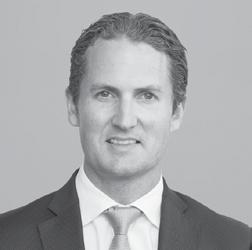
MARTIN HAWES
Martin is the chairman of the Summer KiwiSaver Investment Committee. He’s an authorised financial adviser and offers his services throughout New Zealand.



ANDREW NICOL
Andrew is an authorised financial adviser and the managing partner of Opes Partners. He has more than 15 years’ experience in banking, finance, and property.


KELVIN DAVIDSON
Kelvin joined CoreLogic in March 2018 as senior research analyst, before moving into his current role of chief economist. He brings with him a wealth of experience, having spent 15 years working largely in private sector economic consultancies in both New Zealand and the UK.
ANDREW KENNINGHAM
Andrew is the chief Europe economist for Capital Economics. He was previously an economic adviser for the United Kingdom Foreign Exchange.
CHRIS SMITH
Chris is the general manager at CMC Markets. He has more than 15 years’ investing experience in financial markets, global equity, commodity, and forex markets.
UP FRONT
SPRING 2023 | INFORMED INVESTOR 8
CLARISSA HIRST
Clarissa is the FSC’s head of content, communications and marketing. She also runs point on the FSC’s research, diversity and inclusion initiatives, media and government relations, and consumer projects.

RICH
LYONS
Rich is the retail investment manager of Oyster Property Group. He is responsible for overseeing both retail and wholesale equity raising for transactions, the growth of Oyster’s investors, and continuing to improve Oyster’s service offering to investors.



MIKE TAYLOR
Mike is the founder and CEO of Pie Funds. He’s also portfolio manager of Pie Funds’ Chairman’s, Global Growth 2 and Conservative funds.
VICTORIA HARRIS
Former portfolio manager at Devon Funds, Victoria is co-founder of The Curve, a digital platform aimed at educating women around money.

years in her own accounting practice before co-founding blends psychology and neuroscience with money
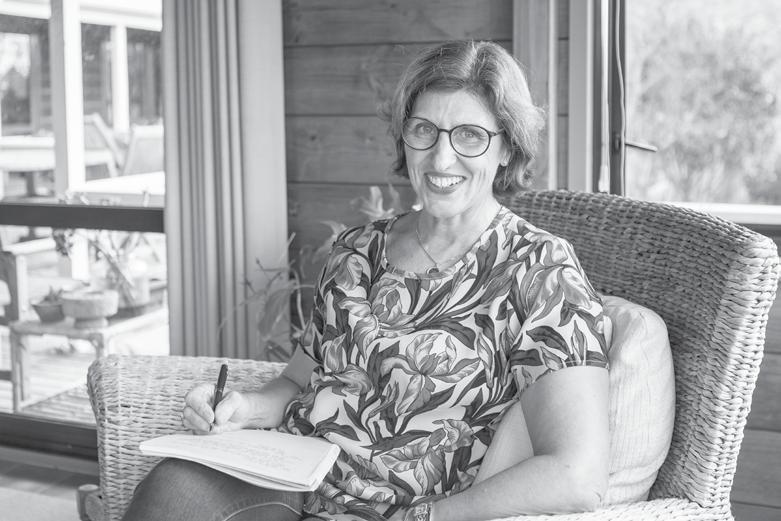
BEN TUTTY
Ben is an Auckland-based but not Auckland-bound property investor and freelance writer. He’s travelled and worked across Asia, Europe, and Australasia, writing for some of the biggest names in property and finance.
CONTRIBUTORS
SPRING 2023 | INFORMED INVESTOR 9
What We Like

A showcase of trends, technology and luxe living.
Coffee for fashionistas
Encapsulating the fusion between fashion and coffee, Dolce & Gabbana has joined forces with Bialetti to reimagine the iconic Moka Express. In celebration of the brands’ Italian heritage and shared love for the morning ritual, the alliance sees a makeover to the stovetop with Dolce & Gabbana’s vision and the charm of carretto siciliano.
Bialetti x Dolce & Gabbana’s limited edition Moka Express is available now in three-cup and six-cup at Sabato or online at Bialetti.co.nz.

Objects of desire
Art+Object auctions are an education in art. Their saleroom viewings are glorious affairs – displayed as exhibitions, they feature some of the best art and design works in Aotearoa.

In mid-September, a significant auction will take place here, when they present Gary Langsford and Vicki Vuleta’s personal collection for sale. Gary Langsford is a New Zealand arts icon, having founded the Gow Langsford Gallery in 1987, and Vuleta is an interior designer who runs Design55. They are downsizing and moving out of Auckland and selling many of their beautiful works.
This presents art lovers a with a unique opportunity to see, and bid on, pieces from some of the world’s leading artists. The collection includes works by Damien Hirst, Judy Millar, Thomas Ruff . . . even Pablo Picasso.

The auction will take place at 6pm on Tuesday, September 19 at the salerooms at 3 Abbey Street, Newton; and online at live. artandobject.co.nz. For more details visit art+object.co.nz

UP FRONT
SPRING 2023 | INFORMED INVESTOR 10
New chatbot for investors
As Kiwis increasingly turn towards selfdirected investing, Tiger Brokers has launched its AI-powered chatbot TigerGPT for the New Zealand market. One of the first of its kind in the industry, TigerGPT is also available in Australia and Singapore. It introduces features that allow investors to research stocks, summarise key insights from earnings calls and releases, and extract pertinent company news and sentiment analysis in seconds based on questions asked by users in the Tiger Trade app. The chatbot is updated weekly. TigerGPT was developed by Tiger

Brokers’ research and development services and engineers to revolutionise investor experience on a larger scale. It demonstrates the crucial role of AI and machine learning in today’s investment industry and is a significant advancement in Tiger’s efforts to empower investors to increase investment efficiency.
Users no longer need to rely solely on keyword searches or sifting through vast amounts of information to find relevant and concise content.
There is a suite of new features to streamline the process of pre-investment decision-making, including personalised stock research which enables investors
to quickly filter stocks based on their own criteria, and show trending market topics. Another key feature is the ability to summarise highlights from earnings calls and releases, offering a comprehensive overview of a company’s performance. Leveraging Tiger Trade’s access to premium data and research, TigerGPT adds data including support and resistance indicators, stock trend analysis and economic calendars.
The full version of TigerGPT is now accessible in NZ through the Tiger Trade app.
WHAT WE LIKE SPRING 2023 | INFORMED INVESTOR 11
Spring is in the Air
Let’s brighten things up and welcome the new season.








ESSENTIALS 6 4 2 1 7 3 5
1. Gorman Sour Straps cylinder vase – gormanshop.co.nz, 2. Merle table lamp – www.achomestore.co.nz, 3. Folded bookend – infinitedefinite.com, 4. Freedom Lune fabric daybed - www.freedomfurniture.co.nz, 5. Superette Sage and Clare Tula Nudie bathmat – superette.co.nz, 6. Freedom Palm Springs fabric occasional chair – www.freedomfurniture.co.nz, 7. Slow Torus vase small – www.slowstore.co.nz, 8. A&C Moro Easy – www.achomestore.co.nz
8 SPRING 2023 | INFORMED INVESTOR 12
Bright accents and cooling whites for hip home highlights.








Make it Pop resene.co.nz/colorshops
Resene Wonderland
Resene Skydiver
Resene Supernova
Resene Pursuit
12 13 14
9. Father Rabbit Bonnie and Neil oven mitts – fatherrabbit.com, 10. Frank Green 34oz reusable bottle – superette.co.nz, 11. Ellis Brooklyn Bee eau de parfum – www.meccabeauty.co.nz, 12. Adairs Daisy Mustard Rust rug – www.adairs.co.nz, 13. Crisp Pen Pen Desk Tidy red – crisphomeandwear.co.nz, 14. Adairs Archie Violet Marle towel range – adairs.co.nz, 15. Coffee Supreme x Maruhiro Hasami block mug tall – coffeesupreme.com, 16. Kit: Universal face lotion – www.meccabeauty.co.nz

Can you Afford a 20-year Holiday?
Having a financial plan can lead to retirement success – and maybe the odd piña colada beachside too, writes Victoria
Personally, I couldn’t afford a 20-year holiday right now. But I could if I had the right financial plan in place, and enough time. And so could you. They say the average length of time we’re in retirement is 20 years. This is a period of time where we are not earning and so are essentially on – a 20-year holiday.
Pension, retirement, superannuation – whatever you want to call it – they all sound pretty boring to be honest. I don’t know about you, but whenever I hear these words, I don’t get that excited. I get flashes of old people, grey hair and community living. However, with the population now leading fitter and healthier lives, the word “retirement” should bring flashes of drinking wine in magical vineyards, cruising on a boat in the Caribbean or relaxing on a beach in the Med.
Exciting phase
We are trying to change the view of retirement as an exciting phase of life. A time where you get to relax, have fun and enjoy the part of your life you have worked so hard for. However, in order to enjoy your “20-year holiday”, you need a financial plan. Nobody will be paying you a salary, so you need to ensure you have enough to pay yourself.
So, how much does a 20-year holiday cost?
A rough rule of thumb suggests you will need 80 per cent of your current salary for every year of your holiday. This will allow you to live your current lifestyle, while on holiday. If you’re
Harris of The Curve.
currently earning $100,000 per year, you will need $80,000 each year, for 20 years. This is $1.6 million. It sounds like a lot but if you’re 30 years old, and haven’t saved anything for your 20-year holiday yet, you only need to invest $700 a month to achieve this by the time you’re 65 years old*. This is only really 8 per cent of your salary and totally doable if you set your mind to it and be disciplined.
Getting started
I mentioned you need a plan, but you also need time. The sooner you start contributing to your 20-year holiday fund, the less you will have to save due to the magical thing called compound interest.
Taking the $1.6m figure, if you waited another 10 years and didn’t start putting money aside to your holiday fund until you were 40 years old, you would need to contribute more than DOUBLE. You would need to put aside $1,500, instead of $700 per month in order to enjoy your holiday. Having a financial plan for any goal is key. Retirement should be exciting, not scary or overwhelming. You don’t want to wake up in a panic the day before your holiday, stressing about how you’ll afford it. Be prepared. Have a plan. And stick to it. Because the only thing you should be stressing about on holiday, is whether to order a piña colada or aperol spritz.
*assuming an average return of 8 per cent per year
The sooner you start contributing to your 20-year holiday fund, the less you will have to save due to the magical thing called compound interest.
WOMEN & MONEY
SPRING 2023 | INFORMED INVESTOR 15
Going Up, Going Down
Economist Cameron Bagrie takes a good, hard look at New Zealand and how we’re going as a nation.
What is sustainable?
The (RBNZ) Committee noted in their most recent OCR decision that “after recent falls house prices are now around sustainable levels”. Adjusted for inflation, house prices are now back at 2019 levels. House prices didn’t feel sustainable back then! The median sale price is still 7.5 times median household income, although it did get up to a multiple of 9.


The R word
Recession? Are we in one? Two quarters of negative growth say so. Continued low unemployment and rising incomes says otherwise. Has the past five years been normal or abnormal? I would say abnormal and a return to normality beckons. That’s a reset and for those conditioned to low interest rates, it’s a big wake-up call. The economy is still operating at a high level of activity, and the level is not consistent with getting inflation to 2 per cent.
The R-word #2
Reset and a repair job. The economy is facing one and I’m not just talking about potholes. Inflation, an 8.5 per cent current account deficit, poor school achievement, rising concerns over crime/law and order, $1.6 billion deficits across local authorities, a poor health system, and fiscal (government) operating deficits, are all gauges of imbalance and an economy that has strayed out of its economic lane.

Taxing times
Government tax revenue is now undershooting expectations, coming in $2.3 billion below forecast in the 11 months ended May 2023, with company tax 10 per cent below expectations. Tax revenue is almost $6 billion below the forecast made in late 2022. The 2023 Budget had lower tax forecasts, and numbers are still undershooting that. The economy is being blamed, but inflation looks the real culprit. Inflation or higher costs hit businesses as well as households.


Jobs
With the profit cycle turning, attention will turn to costs. The number of people on a benefit has risen 8,000 since the start of May.
Staying the course
On hold is the message from the Reserve Bank when it comes to the official cash rate (OCR), with inflation heading lower and the risks noted as balanced. Interest rates can still move even though the OCR need not change. Fixed lending rates are a function of the outlook for the OCR. A key reason fixed lending rates have moved up in the past month is because expectations the OCR could fall in 2024 have been pared back. Term deposit rates have moved up too, which has been good for savers.
SPRING 2023 | INFORMED INVESTOR 16
UP FRONT
Coming down
The annual inflation rate has eased to 6 per cent. The direction of travel is lower. Inflation remains sticky though with non-tradable (domestic) inflation 6.6 per cent and various core measures of inflation around 6 per cent. Six per cent is a long way from the 2 per cent target for inflation. The real inflation rate to households is the cost of food and it is still showing double digits.
Finding a base
The housing market is showing signs of finding a base, with prices now broadly stable month-on-month, days to sell receding from highs and volumes picking up (from low levels). Migration, rising incomes, interest acceptance and loan-to-value ratio changes are pointed to as positive factors. The delayed impact of higher interest rates as fixed loans refix will act as a headwind. One factor not talked about for housing is the switch. Building consents are declining. Construction costs have risen 20 per cent and existing house prices have fallen 15 per cent from their peak. This screws the scrum towards buying existing stock.
Why limited strain?
Bank non-performing loans for housing remain low with around 0.3 per cent of total loan defined as non-performing. Yet we see the media reporting stress. When interest rates fell many borrowers kept payments unchanged, meaning they paid more in principal, getting ahead of their mortgage schedule. Higher interest rates are now biting, but being ahead to start means borrowers have a bit more time on their side before the real stress hits and they fall behind.
Question?
Optimists point to the property market being on an upwards and positive price path. Will inflation continue to come down if that takes place? I doubt it. It might be the cue for even higher interest rates.
The lag in monetary policy

According to the Reserve Bank, “Average mortgage rates on outstanding loans have increased from about 3 per cent in early 2022 to about 5 per cent currently.” With current mortgage rates near 7 per cent, monetary policy is having a delayed effect. Around $170 billion of mortgages are refinancing in the coming year.





Still coming in or already here?
May showed a net migration monthly inflow of 4,938, which is strong but shows an easing trend (previously 7,633). Annual migration rose to 77,809. One thing to note about migration is that the government recently made it possible for some migrants on work visas who had already been living in New Zealand for a period to apply for a special resident class visa. So, the numbers are not strictly new arrivals.
SPRING 2023 | INFORMED INVESTOR 17 Correct as at 25 July 2023.
MARKET INSIGHTS
While Bagrie Economics uses all reasonable endeavours in producing reports to ensure the information is as accurate as practicable, Bagrie Economics shall not be liable for any loss or damage sustained by any person relying on such work whatever the cause of such loss or damage. Data and information have been gathered from sources Bagrie Economics believes to be reliable. The content does not constitute advice.






















































SPRING 2023 | INFORMED INVESTOR 18 UP FRONT
Retirement
/ri-‘tī(-ə)r-mənt/noun



‘Withdrawal from one's position or occupation or from active working life.’




















– Merriam-Webster Dictionary
















































‘I see retirement as just another of these reinventions, another chance to do new things and be a new version of myself.’
QUOTE & DEFINITION SPRING 2023 | INFORMED INVESTOR 19
– Walt Mossberg, American journalist

The Art of Decumulation
For some, a perfectly executed decumulation of wealth means the cheque to the undertaker bounces. Regrettably, perhaps, few people can manage such exquisite timing, writes Martin Hawes.
A lifetime of finance comes in two stages.
The first stage (the accumulation) is about growing wealth; the second stage (the decumulation) is about using your savings and investments to give yourself a good steady income in retirement.
It may come as a surprise to learn that the second stage – decumulation – is by far the harder.
Decumulation is hard because most people in retirement now spend not just the returns from their investment capital, but actually spend the capital itself i.e., they augment the returns that they get by running down their savings and investments.
To decide how much to spend means there is a fundamental tension between spending enough to have the best retirement possible but without spending so much that the money runs out before you do.
For some, a perfectly executed decumulation would mean that the cheque to the undertaker would bounce – that is you would go out on the last dollar.
The rate of drawdown
Regrettably, perhaps, few people can
manage such exquisite timing. Instead, we may overspend and run out of money (most people’s greatest fear) or we play it safe and underspend and forgo things and experiences that we could have had (which is what people do).
The rate at which you can draw down on the portfolio is probably around 5 per cent p.a. That means that if you had $300,000, you could draw around $15,000 p.a. for about 30 years before the money was all gone. This is a rough guide – the figure is probably somewhere from 3.5 per cent to 6 per cent and depends on such things as your age, life expectancy, investment returns, and whether you will increase drawings with inflation.
This is not a matter of simply drawing on the cash returns (dividends and interest) as people used to do – instead you will continue to draw on the portfolio at a steady rate regardless of what is happening in the markets (after all, you need to buy groceries and meet your other regular expenses). This can be quite uncomfortable for some people as they watch the decline of their investment capital.
SPRING 2023 | INFORMED INVESTOR 21 INVESTMENT
‘The best store of wealth invented is the diversified portfolio.’
should extend to investments outside New Zealand.’
The drawdown rate assumes that you have adopted a conventional investment strategy. This would be a well-diversified portfolio with money spread across all the main asset classes.
There are a few retirees who adopt different strategies – e.g. they buy a rental property with the aim of living off the rent, or they invest solely in term deposits and roll these over as they mature.
Accessing capital
Neither of these investment strategies is a good idea: rental property is a single asset which may not perform – e.g., houses are subject to politics with changes to the taxation or possible rent controls. Moreover, property is an asset class where it is difficult to access capital; unlike more liquid investments, you cannot draw cash from property on a regular basis.
Nor is the term deposit strategy right for retirees. The after-tax returns from term deposits are volatile; in the last couple of years gross returns from term deposits have varied between less than 1 per cent to more than 5 per cent. In any event, the returns from term deposits after tax very often do not keep up with inflation (they certainly haven’t in the last few years).

The best store of wealth invented is the diversified portfolio – and this is the best approach for retirees. This means that you have exposure to all the main asset classes (shares, listed property, fixed interest and cash) and that within these asset classes you have a wide range of investments (i.e. you own shares, many fixed interest investments, etc.)
Each asset class may perform differently depending on the prevailing economic conditions. Retirement may be for 30 years or longer, and over that time anything may happen. The whole point of a diversified portfolio is that one investment class will perform while others are not.
Global shares Diversification should extend to investments outside New Zealand. For example, most likely you will have global shares in your portfolio to cover you from something bad happening to NZ. Think about a major biosecurity breach (e.g., foot and mouth disease) and think further about what would happen to your retirement in the resulting economic and currency collapse – international investments would act as a kind of insurance.
In most cases this will mean using managed funds of one sort or another. For example, you may use a KiwiSaver fund – people over 65 can put money into a KiwiSaver and take it out again. Some people may establish an investment account through a
financial adviser and have them make their investments.
A small number may take a DIY approach, but be careful with this: few people have the skills or are prepared to devote the time to managing their own investments. You will only have one retirement and getting your investment strategy and drawdown rate right is critical. If there was ever a time to get some good advice, this would be it.
Martin Hawes is a financial author and speaker. He is not a Financial Advice provider nor a Financial Adviser. The information contained in this article is general in nature and is not intended to be financial advice. Before making any financial decisions, you should consult a professional financial adviser. Nothing in this article is, or should be taken as, an offer, invitation or recommendation to buy, sell or retain a regulated financial product.
SPRING 2023 | INFORMED INVESTOR 22 FEATURES
‘Diversification




Cashflow feeling the squeeze? 4.9 out of 5 Rated ‘Excellent’ from over 1500 reviews Available on the Web, iOS & Android in rent reconciled through myRent $664M 5 star reviews by our landlords 1,373 NZ‘s most trusted landlord software 24,000 landlords Save $2,000+ on management fees using myRent. *
It’s All About Planning for the Golden Years
It’s never too soon to start picturing the kind of retirement you might want and thinking about what you can do to make it happen, writes
Amy Hamilton Chadwick
Are you on track for retirement? It’s perhaps the fundamental financial question for anyone aged over 45 because the stakes are so high. Get it wrong and you could be living a hard-scrabble existence into your 70, 80s, and 90s.
But it also goes beyond just the financial questions. Once you do retire, what will you do with your time? Do you want to work at all? Do you want to travel? What are your priorities in your later life?
It’s never too soon to start imaging the kind of retirement you might want, and thinking about what you can do to make your ideal retirement possible.
NZ Super isn’t enough
An astonishing 40 per cent of Kiwis aged 65-plus have almost no income other than their superannuation, according to Older People’s Voices, a report by Te Ara Ahunga Ora Retirement Commission (TAAO). Those individuals told researchers they often had to forgo essentials, including food, health or power.
“It’s a huge concern,” says David Callanan, general manager of Corporate Trustee Services at Public Trust. “NZ Super is there to
maintain a minimum quality of life – people find a way to live on it, but it’s pretty tough and they tend to be living hand to mouth.”
He says more people could avoid this position by planning ahead for retirement, particularly when it comes to KiwiSaver. Increasing your contributions can have a small impact on your life now but will make a significant difference once you stop working. Callanan would like to see higher employer and employee contributions – mandatory employer superannuation contributions in Australia, for example, are 11 per cent. He would also like to see help for people in default funds to engage more with their savings and consider switching to a highergrowth option.
“You can’t just wing it; you have to have a plan for retirement, so you can continue your quality of life beyond your working years,” Callanan says. “Use the power of accumulation and long-term investing – the sooner you start, the sooner you get the benefit of the accumulation. When you get a pay rise or change jobs, it’s the perfect time to think about whether you can increase your KiwiSaver contribution.”
SPRING 2023 | INFORMED INVESTOR 25 RETIREMENT
‘Those feeling comfortable in retirement tended to be disciplined and careful; they owned homes, saved money, and invested in KiwiSaver.’
The kind of work you want
That pay rise or job change might also be a catalyst for thinking about how you’ll work after you turn 65, if at all.

When the company Ian Fraser managed went under, he was in his late fifties, and he was surprised by how difficult it was to find another job. He had expected it to be an easy process after a good career in management, but instead it was a struggle. That experience led him to set up Seniors@Work in 2019, a job platform specifically for those aged 50-plus. It’s been growing rapidly over the past four years. Fraser is now 71, and still enjoying work. He likes the mental challenge, and he appreciates the income; he and his wife are paying off the mortgage and like to visit their two adult children in London. He mixes up a few different part-time jobs, working around 30 hours a week, with a plan to step back a bit once he turns 75. He’s not the only older Kiwi who’s enjoying work. The 2023 Working Seniors Report found that more than half (51 per cent) of those aged 50-plus say they are “very satisfied” or “extremely satisfied” with their job, and 81 per cent believe that staying in the workforce longer is a good thing for Kiwi seniors.
If you plan to work beyond 65, think ahead, says Fraser. You won’t be able to do a physical job into your 70s, so you may need to pivot towards a lower-impact role. And don’t expect to be able to walk into your dream job, even if your career has been an impressive one. “The dynamic is different, and recruiters are only interested in your last 10 or 15 years of experience, so rethink your CV,” he advises.
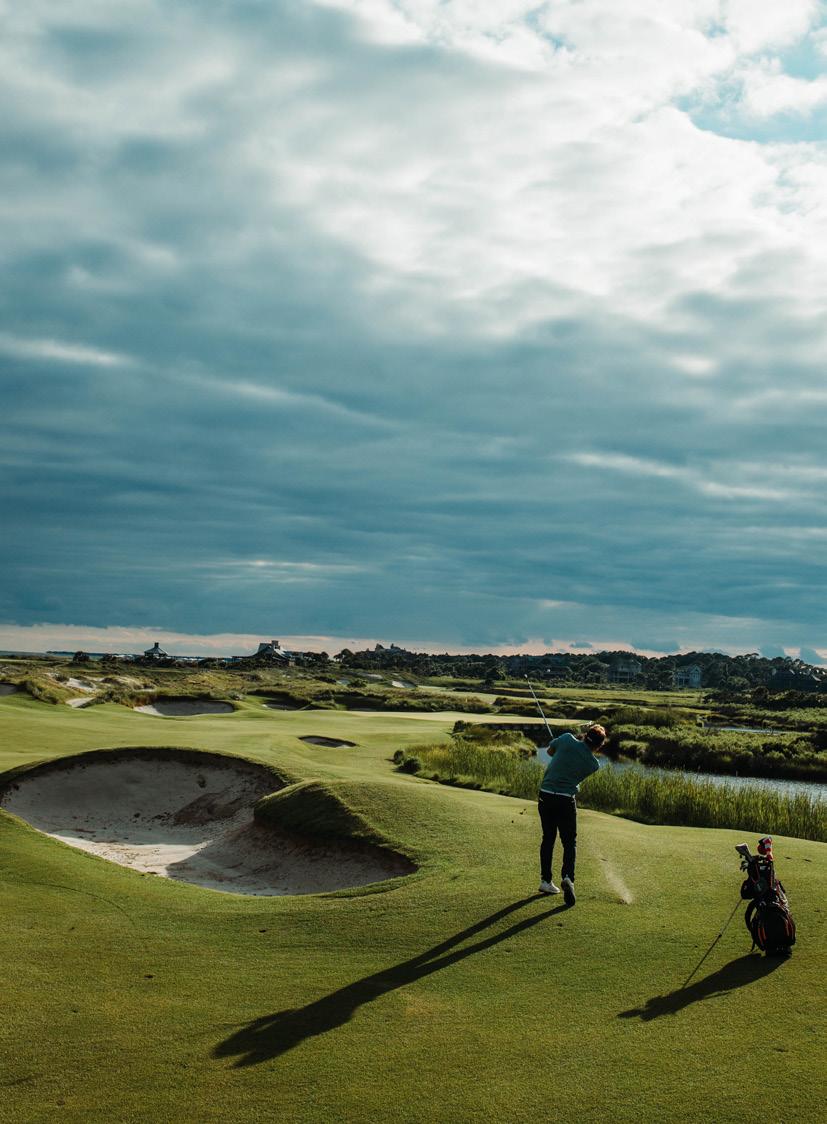
Heartland Bank Limited’s responsible lending criteria, T&C’s, fees and charges apply.
forfinancial freedom in retirement? If you’re over 60, a Heartland Reverse Mortgage could help take the stress out of everyday expenses, along with covering home repairs, consolidating debt and much more. If you want to find out how you can live a more comfortable retirement, call us on 0800 488 740 or visit us at heartland.co.nz FEATURES
Looking
“Take up any opportunity to upskill if it’s offered, and consider your transferable skills, don’t shy away from them.”
Financial literacy a boost
You should also take any opportunity to upskill your financial knowledge, because this can have a significant impact on your long-term wealth. Understanding the basics of managing your money, including how and why to invest in different types of assets, leads to more positive outcomes regardless of your level of formal education.
One United States study estimated that people who are financially literate will retire with 30 to 40 per cent more wealth when compared to those with no financial literacy.
“This is a very high number, but it’s also not surprising,” author Dr Annamaria Lusardi told a podcast in 2022. “We might have the same income, we might have the same education, but if I invest in stocks and you don’t invest in stocks, 20 years later we might indeed look very different.”
This was echoed by respondents in Older People’s Voices, who were asked what advice they would give their younger selves. Their suggestions included “start learning about money when you are young,” and “be responsible for your own financial literacy”.
How assets can support you
The Older People’s Voices report found that those feeling comfortable in retirement tended to be disciplined and careful. They owned homes, saved money, and invested in KiwiSaver, property and other assets (and inheritances helped, too). As those disciplined savers know, the right investments can set you up for a high-quality retirement that includes travel, restaurant meals and plenty of treats for the grandchildren.
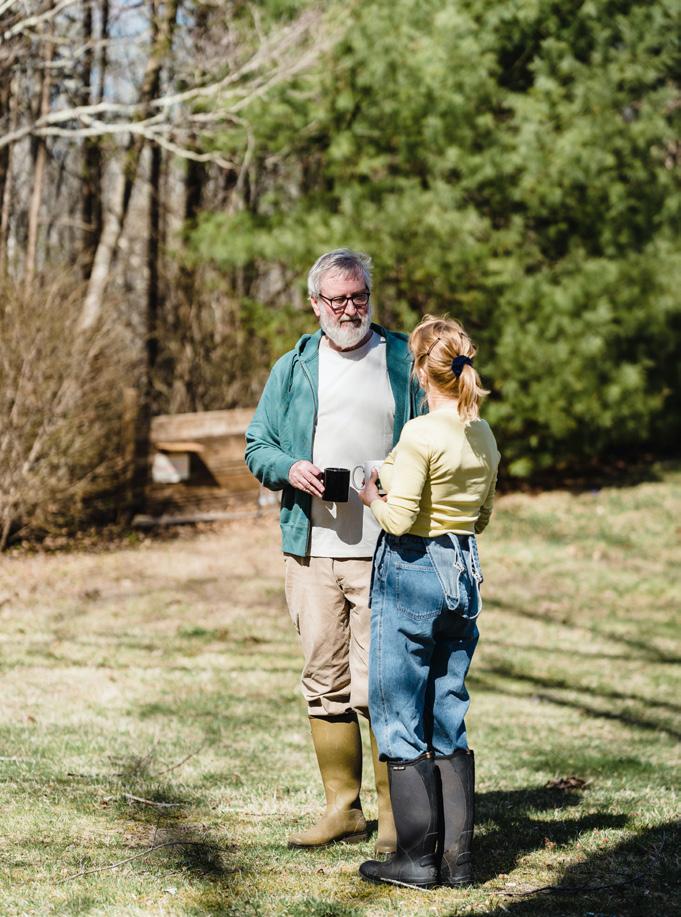
Income-producing assets can give you passive income – money that keeps flowing in even when you’re not working. This means investing in assets like shares (including via KiwiSaver), property, or a business. There are varying levels of risk in each approach, but the sooner you start the more time you have to recover if something goes wrong. Once you stop working, these assets can continue providing you an income, or you can sell them and use the profits to meet your costs.
Your home isn’t (usually) an incomeproducing asset, so you may need to work a little harder to make use of the equity you’ve built up over the years. You can turn your equity into cash by downsizing or borrowing against it – plan ahead and do your homework so you understand how and when these strategies can work.
“In our research, people told us they would like to downsize but they couldn’t find suitable properties,” says Dr Suzy Morrissey, director, policy and research, TAAO. “That generally means a property in the right area that is accessible. You might want a house that’s on one level, for instance. I live in Wellington, so here it might mean a house that doesn’t have 30 steps to the front door. Staying in the family home sounds nice from an asset perspective, but it’s not always the most appropriate place for older people.”
She adds that Kiwi retirees are often “asset rich, cash poor”, but home equity release products aren’t necessarily well-regarded by the public, even though they can be very useful in certain circumstances. While they won’t suit everyone, it’s worth finding out more about them to understand if they could be a way to fund the later years of retirement.
‘Whether you want to travel extensively, quit work and play golf full-time, or pay for your grandchildren’s education, the sooner you start planning the better.’
SPRING 2023 | INFORMED INVESTOR 27 RETIREMENT
Doing nothing the biggest risk
Not sure how to get started on investing for your retirement? Ask yourself what you want your retirement to look like, says Lisa Dudson, financial expert and author of Good with Money. That’s the question Dudson asks her clients, and as long as the result is a realistic one, she uses the answer to come up with financial targets, then creates a road map to help put them on the right path.

“That gives you a rough plan, then you need to do regular check-ins where you re-check your numbers and what you want your lifestyle to look like – variables do come along so you need to be nimble.”
These days there’s a lot more flexibility in the way we can live and work, which can help you achieve the kind of lifestyle you want.
One of Dudson’s clients wanted to quit his job and spend more time travelling. After asking a few questions, Dudson suggested that instead of quitting his job, which he still enjoyed, he should negotiate with his employer to work remotely for four weeks a year. Along with his annual leave, that allowed him to keep earning a full-time salary while enjoying an enviable lifestyle of regular travel and adventure.
Whether you want to travel extensively, quit work and play golf full-time, or pay for your grandchildren’s education, the sooner you start planning the better. Talk to a financial adviser, boost your financial education, set your goals and get yourself on track.
“I meet a lot of people who have procrastinated for so long that they’ve done nothing for years, and they’ve missed out on a lot of opportunities to take advantage of the power of compounding over time,” says Dudson. “Unfortunately, a lot of people are immobilised by fear – but doing nothing is a huge risk. Don’t get yourself tied up in knots, just make a start. Anything is better than doing nothing.”
Close Look at the FIRE Movement
The FIRE movement – financial independence, retire early – has captured imaginations around the world. Why not retire when you’re in your thirties or forties? FIRE makes this possible: you live frugally for years, saving up a lump sum and investing it in such a way that you can live off the passive income. You never need to work again, although your spending will be tightly restricted.
Although retiring early can be a dream come true, life tends to get in the way of even the most impressively well-laid plans. One unnamed IT professional used the lean FIRE method to retire at 37 with US$950,000 in assets. He found that the first few years of reading, relaxing and travelling were brilliant. However, he was hit by two of the big three life shocks: his marriage broke down and he had health problems. With higher-than-expected costs, he re-entered the workforce five years later.
“Yeah, without my former partner I became depressed and anxious and again struggled with one of the great questions that terrorises us all: purpose,” he writes at LivingaFI.com. “I realised I needed more out of life. The discomfort; that growing sense of unhappiness, the creeping edges of depression just out of my direct line of sight as though it’s hiding in the periphery at all times. That discomfort did exactly what it was supposed to do. It prompted me to make some major changes that
The Three Big Life Shocks
Even if you are currently heading for a comfortable retirement, major life events can change the direction.
“The three big life shocks are: a relationship breakdown, a serious health problem or disability, and redundancy,” Dr Suzy Morrissey says. “When someone has been on track for retirement and then they’ve been derailed, it’s usually by one of these.”
As much as possible you want to take care of your relationships and your health, but these big life shocks can still happen. It may be worth considering income insurance and health insurance, Morrissey
moved me in the right direction. As far as failures go, it was a good one.”
He met someone new and set about building a new life. He’s still financially independent, because his assets grew during those five years to US$1.3 million, but he’s working so he can support a higher-spending lifestyle and possibly children. It’s a great reminder that an important aspect of FIRE is the financial freedom to choose, not necessarily the ability to lie on the beach all day.
“All of my saving and investing in my 20s and 30s has positioned me to do whatever I wanted, more or less. It has given me freedom to make choices, exactly as I’d hoped it would all along.” suggests, to mitigate the financial impact of either of these problems.
A separation later in life can throw a spanner into all your financial plans. When home-owning couples separate and sell their house, there’s often not enough cash left over for both parties to each buy another house.
“When you go through a separation, you’ll probably engage a lawyer, but you should also think about engaging a financial adviser,” says Morrissey. “Think about the assets you’re taking, and which ones are appreciating assets, and what their value is, including your KiwiSaver, because that’s relationship property and it can be split in a separation.”
SPRING 2023 | INFORMED INVESTOR 28 FEATURES
‘I meet a lot of people who have procrastinated for so long that they’ve done nothing for years, and they’ve missed out.’
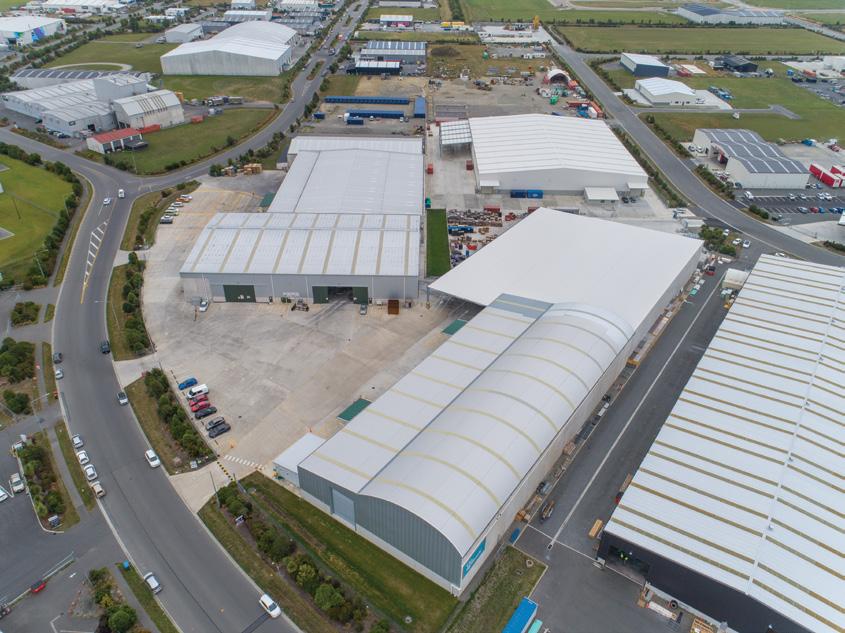


Get in touch with our team to nd out more about PMG funds and investment opportunities 07 578 3494 pmgfunds.co.nz With a track record of stability, continuity and performance, we value growing relationships as much as we value growing returns. We invest alongside our clients, sharing both the risks and returns, our directors and team have skin in the game too. Established over 30 years ago, PMG Funds is one of New Zealand’s largest licensed commercial property fund managers. The information in this advertisement is of a general nature and was current as at 15 June 2023. It is not intended to be regulated nancial advice for the purpose of the Financial Markets Conduct Act 2013, and does not take your individual circumstances and nancial situation into account. PMG does not provide nancial advice. Please seek advice from a licenced nancial advice provider before making any investment decisions.

5 PRINCIPLES FOR GROWTH
Guy Thornewill Head of Global Research
Michelle Lopez Head of Australasian Equities and Portfolio Manager
NZ OFFICE AU OFFICE UK OFFICE
Mike Taylor Founder and CIO
How we find quality growth companies
Investing in the stock market can be risky. There’s a lot to consider, requiring an examination from the bottom-up of stock-specific risks while also studying the broader top-down influences in the geography and sector a stock operates in.
In our 15 years of investing at Pie Funds, five key principles have provided us with a robust investment process. Our investment teams use these principles to help identify potential areas of risk, ways to reduce those risks and help build resilient portfolios that can perform even when the markets are tough.
Principle One: Skin in the game
Our staff, directors and shareholders are invested in our funds, so we treat it like it’s our money as well, and look for this level of commitment from the founder-led companies we invest in.
Principle Two: Fundamentals
We examine a company’s fundamentals, approaches and practices, looking for long-term viability and growth potential.
Principle Three: We invest in people
We invest in quality businesses with proven management teams. If the people change, we review our investments.
Principle Four: We like to see tailwinds
We look for emerging market leaders and get in early, so we’re there for the ride up.
Principle Five: Plan for a rainy day
We’re long-term thinkers and are ready to act when we see a threat or opportunity.
These principles – combined with having investment teams based not only locally, but also in Sydney and London to meet directly with potential business leaders in-person – help us identify stocks we think will outperform the market in the long term. We stick to these principles whether markets are up or down.
Our core investment objective, which has not changed since Pie Funds launched, is to find high-quality growth companies with strong balance sheets and great management teams. And our five principles help us deliver that objective to our clients.

Funds Management Limited

the manager of the funds
the Pie
Management Scheme.
disclosure
please
Any advice
given by Pie
Management Limited and is general only. Our advice relates only to the specific financial products mentioned and does not account for personal circumstances or financial goals. Please see a financial adviser for tailored advice. You may have to pay product or other fees, like brokerage, if you act on any advice. As manager of the Pie Funds Management Scheme investment funds, we receive fees determined by your balance and we benefit financially if you invest in our products. We manage this conflict of interest via an internal compliance framework designed to help us meet our duties to you.
Contact us on 09 486 1701 or email clients@piefunds.co.nz to find out how we can help you.
PIEFUNDS .CO.NZ
Pie
is
in
Funds
To see the product
statement,
visit www.piefunds.co.nz.
is
Funds

Reverse Mortgages Can Be a Sensible Option
For Kiwis over 60 years old, with enough equity in their own home, there are options that can provide financial relief.
Living through challenging financial times is difficult for many Kiwis, with the increased cost of living. Seniors are especially hit hard with inflation sitting at 7.1 per cent.
With high interest rates on credit cards and personal loans, it’s understandable that people are hesitant to borrow money, especially once they retire. However, for Kiwis over 60 years old, with enough equity in their own home, there are sensible ways that can provide financial relief.
This is where accessing some of the equity in your home with a reverse mortgage can be a sensible option, to help fund a more comfortable retirement.
According to Stats NZ, the cost of living for the average Kiwi household increased 7.7 per cent in the 12 months to March 2023. This follows an 8.2 per cent increase in the 12 months to December 2022.
For many, it can be a real struggle to fill up the shopping trolley, pay the electricity bill or book a hairdresser, let alone make those well needed home improvements or grab a well-deserved getaway. Some retirees are in a position to draw down on their savings, like KiwiSaver or other investments. However, this still may not be enough.
Tight times
Research by Te Ara Ahunga Ora Retirement Commission shows 40 per cent of people aged 65 and over have virtually no other income besides NZ Super. And another 20
per cent have only a little more. Even with NZ Super, close to one in three people don’t think they will have enough for retirement unless they continue working past 65.
With a Heartland Reverse Mortgage, the total loan amount, including accumulated interest, is repayable when you move permanently from your home. This could occur when you sell your property, move into long-term care, or pass away.
Heartland Bank general manager, retail, Keira Billot, says: “The amount you can access depends on your age and the value of your home. You have the flexibility to repay the loan partially, or in full, at any time without paying penalty charges.
“You can use the money for a number of things. However, we are seeing an increasing number of customers using their reverse mortgage to consolidate debt, such as paying off credit cards or their standard mortgage, taking the pressure off having to make regular repayments.
“The most common reason people take out a Heartland Reverse Mortgage is for home improvements and repairs. Debt consolidation is now the second most common reverse mortgage loan purpose, which demonstrates the financial difficulties over 60-year-olds are facing as they enter retirement.”
Easy to manage
A Heartland Reverse Mortgage is easy to
manage and provides protections, such as no regular repayments until you sell or leave your home, lifetime occupancy, and a no negative equity guarantee, which means the amount required to repay the loan will never exceed the net sale proceeds of the property.
A Heartland Reverse Mortgage can also be used to top up your monthly income, with an Easy Living Monthly Advance. You can also take a reverse mortgage against a secondary property, such as an investment property or holiday home. A Secondary Property Loan provides you the same benefits of a reverse mortgage on your primary home.
A reverse mortgage is not for everyone, but in many cases it can be transformational. To be eligible you need to be over the age of 60, own your own home outright, or have a standard mortgage that can be paid off by the reverse mortgage. Heartland’s customers must seek independent legal advice, and are encouraged to seek independent financial advice and speak to family.
Heartland Bank is the leading provider of reverse mortgages in New Zealand and for the past 20 years has helped more than 22,000 Kiwis enjoy more freedom in their retirement.
Applications are subject to loan approval criteria. Heartland Bank Limited’s responsible lending criteria, fees and charges apply.
HEARTLAND BANK
SPRING 2023 | INFORMED INVESTOR 33

The Benefits and Rules of a Good FIRE

Ben Tutty settles in to examine the flames fanning a very different way of living.
You know the drill. You’re going to work for almost 50 years until you’re 65 and retire for 20 or 30 (sigh). But what if it could be different? Financial independence retire early, or FIRE, is a way of living that has enabled many to break free from the traditional 40 or 50-year working life. Glorious as that may sound, there’s no such thing as a free lunch (or retirement) and FIREing can require significant sacrifices. Is it all worth it?
Ruth aka The Happy Saver is New Zealand’s most prominent FIRE fan. She lives in Alexandra with her partner Jonny and teenage daughter and held $422,000 in broad-based index funds as of May 2023.
She’s 49 and Jonny’s 50, but they’re both semiretired and work two days a week at super flexible, relaxed jobs that fit nicely around their lifestyles. Ruth also blogs at happysaver.com about her journey. When I asked her if she was happy, there was no hesitation.
“What’s not to like? I’m chuffed, sometimes I still can’t believe it. Life should be balancedand that comes from being able to choose how you live it.”
INSIGHTS SPRING 2023 | INFORMED INVESTOR 35
Hard to disagree with that. But how do Ruth and other FIRE adherents actually make it happen?
Obviously, FIRE requires a chunk of change. To build their wealth FIRE adherents usually do three things:
1. increase their income
2. decrease their expenses
3. invest as much as they can.
Hustles and spending
To increase their income FIRErs might pick up side hustles, rapidly advance in their careers, or even choose the most lucrative career path possible so they can FIRE. They may also be mindful of their spending (and in some cases extremely frugal) to ensure the gap between their income and costs is as wide as possible.
Last of all FIRErs will usually invest 50-70 per cent of their after-tax income into savings and investments, typically broadbased index funds with low fees (Ruth does around 30 per cent). And then when it’s finally time to retire they use something called the 4 per cent rule.
This widely-used rule assumes that if you can live off just 4 per cent of your nest egg per year in retirement it should outlast you. This rule is based on American research so it’s not as proven in New Zealand as it could be, plus some US financial advisers say 3.3 per cent is more accurate in the current economic climate.
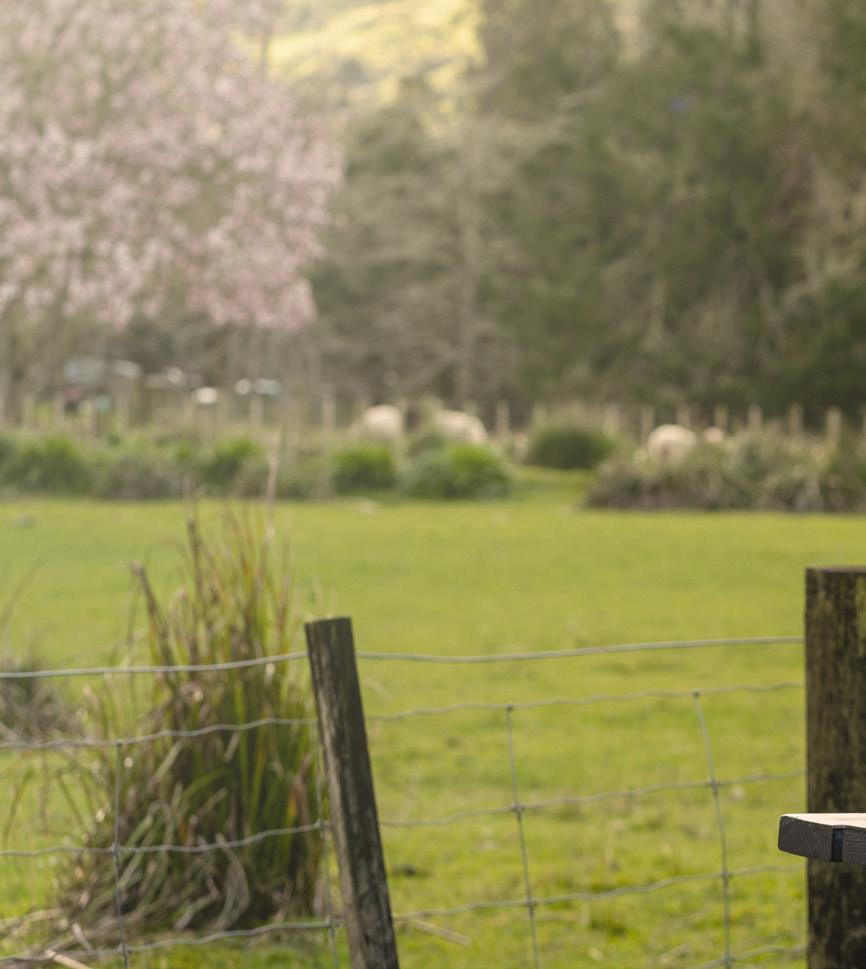
To give you an idea of how much you might need: if you were to live off $50,000 a year, you’d need $1.25 million to retire, according to the 4 per cent rule.
FIRE is an amazing concept, with a lot of good ideas to offer, but there’s no denying it’s harder for Kiwis today than it was in the past.
For one, New Zealand’s median house price was around 3.2 times the median income back in 2001. In 2021, it was 9.3 and in 2023
it’s 7.17, according to REINZ and interest. co.nz. That means a mortgage will eat up a much larger portion of your income that might have otherwise been savings and make FIREing more difficult.
The cost of living is also rising much faster than wages and renting for life is more common (which of course makes FIRE harder). Ruth personally benefited from much lower house prices and admits it’s harder now, but she’s confident it’s still possible. It just takes sacrifice.
The sacrifices
Like any financial philosophy FIRE is not without its risks and drawbacks, according to James Blair, wealth director at Lighthouse Financial, an Auckland financial advisory. He agrees it’s got harder for young
people, but reckons it misses the point.
“Financial independence is not a crazy concept. There’s nothing wrong with wanting freedom, but the hardcore FIRE community will live on maybe 10 to 30 per cent of their income.
“They sacrifice the best years of their life for this magical future. They won’t do as many trips or have those special experiences, just to rush to retirement. I think if you hate your job that much, you’re clearly doing the wrong thing.”
On the flipside Blair draws attention to rising credit card default rates and the popularity of Afterpay. Lots of Kiwis have trouble with living in the moment a little too often and racking up debt that they’ll
SPRING 2023 | INFORMED INVESTOR 36 FEATURES
‘If you were to live off $50,000 a year, you’d need $1.25 million to retire, according to the 4 per cent rule.’
pay for later. Blair reckons it’s all about finding a balance, a middle ground that works for you, which is somewhere between FIRE and YOLO (you only live once).
“We believe in holistic financial planning. It’s not about more property, more money, more shares. It’s all about what’s important to you and your family. Making short and long-term goals, then prioritising them.
“The reality is everyone wants to achieve everything, but you’ve got to choose and make sacrifices.”
Blair’s way sounds good too. And if you wanted to FIRE, chances are he’d be able to help you make it happen. But he says most of the successful, happy people he knows don’t want to stop working.
“Ideally your identity as a person is tied into something you care about. Working is not linked to income. And while it’s nice to have that freedom, it’s really about finding that match between your passion and your skillset.”
Blair isn’t just talking; he clearly means what he says. When I asked him if he would change anything if money wasn’t an issue he said: “My life wouldn’t look much different. I’ve got an eight-month-old son and a wife at home so maybe I’d spend more time with them and travel a little more. But I’ve got the sweetest job. I get to help people live the lives they want to live.”
It’s not all or nothing Ruth says Blair has a point when it comes to
hardcore FIRE adherents, but most Kiwis aren’t keen on doing things that way. “Nobody wants to be that person who brings the cheapest bottle of wine to a BBQ and takes half home. The people I meet doing FIRE in NZ are not like that. They’re 30 or 40 and going about life as usual. They’re not miserable.”
For Ruth, FIRE is all about having f$#k you money: the freedom to do whatever she wants. She works two days a week in a friend’s business in a way that fits around her lifestyle and allows her to spend plenty of time doing what she wants to do. Both her and Jonny hang out with their daughter frequently, help out the community and spend more time doing things that don’t make money.

SPRING 2023 | INFORMED INVESTOR 37 INSIGHTS
“There’s something to be said about having parents who are present, surely.”
And while she says she’s definitely had to make choices, she doesn’t feel as if she’s sacrificed anything at all. “Some people try and say with FIRE you can have everything, but you can’t. Just like you can’t keep eating chips and chocolate if you want to lose weight.
“With that said, I don’t feel as if I’ve given up anything that I really want. It’s all about feeling content with what you’ve already got. And when you’re always content, that’s when happiness really comes.”
FIRE also stands for freedom
Ruth explains that if you can be content, you don’t need as much to retire as you may think. The oft-quoted figure of $1 million is way over the top for most people, she reckons. You also don’t need to stop work completely; FIRE is more about having the freedom to do whatever you want.
“I personally love working so FIRE for me is continuing to work because I like it. I like the customers and I also love writing my blog. It’s exposed me to thousands of Kiwis who are changing their lives.

“Another Kiwi FIREr I know is a 39-year-old engineer who’s completely stopped working. He lives in Central Otago and occasionally he’ll run bike trails for tourists during the summer because he loves it.”
Ruth admits FIRE may not be for everyone. But with that said, four out of 10 Kiwis are unhappy in their jobs and completely disengaged, according to culture coach Shane Green. Ruth reckons people often stay in jobs like this because they think there’s no other option, when there clearly is.
“What has become of us if we want to spend 40-plus hours a week toiling, usually for someone else. And why is it that if many of us did have more freedom, we wouldn’t know what to do with it?”
SPRING 2023 | INFORMED INVESTOR 38 FEATURES
‘FIRE is an amazing concept, with a lot of good ideas to offer.’

We lease, we sell, we manage, and we know how to increase the value of your Commercial Property. When results matter, you’ll want to talk to our specialist team. 0800 367 5263 | pb.co.nz/commercial Commercial Real Estate Property Brokers Ltd Licensed REAA 2008 PB057378
The Road to an Early Retirement Deserves a Good Map
The ebbs and flows of profits, property valuations and share markets can muddy someone’s ‘clear’ vision of their path to FIRE, but there are strategies to help, writes Mike
Taylor
The desire to have enough money to retire early isn’t a new one, but the number of roads you can take to get there has definitely grown in the last decade or so. The advent of new technology has created a lot of opportunities for entrepreneurs and generated increased discussion on the idea of being financially independent and retiring early (FIRE).
But an element the discussions sometimes gloss over are the truths about getting to that point. You can do as much forecasting as you want, plugging figures into calculators and projecting returns, but you won’t be able to forecast shifts in markets, crises or the rise and fall of companies. It’s important to remember you aren’t guaranteed a 10 per cent annual linear return. The ebbs and flows of profits, property valuations and share markets can muddy someone’s "clear" vision of their path to FIRE.
Some people try to address this by mapping out a more conservative overall return estimation, but that still leaves you potentially vulnerable if all your eggs are in one basket. Some years will be better, some may be quite worse – it’s important to plan ahead to try and handle these situations and ensure a drop in one area won’t torpedo your retirement goals.
Diversification so important
This is where diversification comes into play. By splitting your money across several different areas, you reduce your risk. While
this may be touched on from a high level by proponents of FIRE (or those discussing retirement in general), the details of what diversification looks like are all too often skimmed over.
Anyone worth their salt that’s covering FIRE or retirement should be hammering home the idea of diversification, and the right kind of diversification at that. It’s about investing what you have wisely, across several asset classes – including property, shares in different markets, cash, bonds and even alternatives – you can find just about anything in an ETF these days. And you should do all this without overly exposing yourself to one particular area. Don’t just put all of it into a single tracker fund and close your eyes.
This diversification is also important from a global perspective. Economic cycles happen at different paces across the world, meaning a lull in one market can see great opportunities in another. An example of this is how tech stocks in the United States essentially wrestled the S&P 500 back into a bull market in June, while NZX and ASX markets lagged. So, when looking at managed fund providers, be sure to find one that has exposure to different global markets.
The importance of due diligence cannot be overstated. If the company you’re investing in or the house you’re buying isn’t fundamentally sound, your money can quickly turn to smoke. For us, we use
five key principles to guide our investment choices. These principles are designed to help us ask the right questions, allowing us to determine the suitability of assets and investments.
Due diligence
And just like with the theoretical house or company, you need to do your due diligence when picking a fund manager. Talk to those you’re considering entrusting with part of your retirement nest egg, read reviews and find out as much as possible so you can be confident they’ll have your best interests at heart. You want to make sure they’re focused on long-term growth and don’t just follow the latest trends.
Planning for a safe and
secure
retirement isn’t a pipe dream, whether you end up retiring early or decide to work well into your 70s.
But the key to securing it is to look at all your options, ensure your eggs are wisely spread to avoid potential risks, and to try to work unexpected volatility into your planning. So, whether you’re embracing the FIRE concept or are just looking to safeguard your retirement, putting some of your money into a managed fund is a wise option, along with investing in other areas.
SPRING 2023 | INFORMED INVESTOR 41 PIE FUNDS
*Mike Taylor is the CIO and Founder of Pie Funds. You can view our disclosure documents on the Pie Funds website. For personalised financial advice, please speak to a financial adviser.
The Art of Engagement
Technology opened the arts to a new audience over lockdown, and it’s changing the way we collect, as Joanna Mathers explains.
Covid lockdowns thrust so many of life’s pleasures out of reach. Dining out, attending concerts, travelling overseas –stuck inside our homes, the world retracted within our walls.
Technology took on an outsized importance at this time, the internet facilitating connections to life outside our houses. The art world wasn’t exempt from the tsunami of digital. We were deprived of real-life encounters, and new technologies were welcomed, including those that allowed us to engage with the arts.
New York’s Metropolitan Museum of Art partnered with wireless network operator Verizon to provide anyone with an internet connection access to digitally rendered galleries, offering online access to nearly 50 works of art. Art Basel, the world’s most exclusive art fair, launched virtual viewing rooms; interest was so overwhelming that the site crashed.
A recent Art Basel report revealed that online-only sales peaked in 2021 at $13.3 billion; 85 per cent higher than in 2019.

Aotearoa hasn’t been immune to this trend. When Auckland’s Art+Object auction house introduced online-auction technology they increased their audience in the process.
“I don’t have any specific figures,” says Leigh Melville, managing director and part owner. But suffice to say that we have seen a significant increase in people taking part in our auctions, now that they are held both online and in person,”
Embracing the virtual New Zealand’s active artistic community has long been championed by passionate collectors. They are prepared to spend large amounts to secure works by their favourite artists.
But the rarefied air of the auction room, where people “in the know” spend millions on exclusive artworks, can be intimidating. And lockdown provided a unique opportunity for new or curious collectors to engage.
Art+Object had been dabbling with the idea of online auctions prior to the Covid lockdowns, as Melville explains. But there had been resistance because “we were founded on the concept of presenting art in a meaningful way”, and in real life.
So, when Covid reached our shores, there was a level of pessimism around what it would mean for their auctions.
Like so many workplaces, Art+Object “pivoted” fast-forwarding their online offerings and creating an app through which the public could engage with auctions. And this change expedited huge growth in registration for auctions.
“It was a big change for us, but the technology was embraced and the online auction appealed to a wide range of people. There’s no hierarchy and it’s not intimidating.”
Market broadens
Established collectors may have been at home in the “real world” auction house, but
for Millennials and Gen Z online auctions offer a comfortable alternative. The Hiscox Online Art Trade Report reveals that 71 per cent of worldwide online sales were made by people under the age of 54, with 47 per cent being between 18 and 34.
It’s apparent that the move to digital has significantly broadened the reach of art collection. Instagram, for example, allows artists to communicate directly with the public. “Instagram is a great friend of the artist,” Melville agrees.
Nevertheless, there is still a significant market for the celebrated names, which Melville speaks of as a “flight to quality” even amid economic downturn.
“The best pieces will always find a home, even in recession,” says Melville.
And while Melville doesn’t like to talk about art in terms of “investment”, she acknowledges that the right works have the
SPRING 2023 | INFORMED INVESTOR 42 FEATURES
power to exponentially increase in value. She uses the example of a work owned by celebrated collectors Tim and Sherrah Francis entitled The Canoe. They bought this Colin McCahon painting for just $500 in 1969.
When the Francis’ collection was sold posthumously at Art+Object in 2016, it changed hands for a [then] record price for a New Zealand painting of $1.35 million. And Michael Parekōwhai’s A Peak in Darien sold for a record $2,051,900 at an Art+Object auction in 2021.

Investing in ourselves
These figures are an indication of the importance local collectors place on local art. “We like our own art,” says Melville. “Local collectors don’t tend to be great collectors of art from overseas.”
There is immense pride in the quality and “punch-above-our-weight” nature of the art
of Aotearoa; an acknowledgement of how hard our artists work to be seen.
Melville points to our offerings on the international stage as an example. Simon Denny’s 2015 work at the Venice Biennale Secret Power, an incisive look at Five Eyes was lauded by many leading international news outlets as one of the most important national pavilions that year.
Don Binney’s work has seen significant increase in value recently, she says, with a piece selling for over $1 million. And contemporary artists like Michael Parekōwhai, are also fetching high prices at auction.



Starting out
That level of investment is likely to be beyond the means of new collectors. But younger people, who may have had their eyes opened to the potential of art via
Instagram et al, are likely to increase their art education through online or real-life auctions.
“It’s a great way to view the bodies of works of a range of artists, alongside different art forms,” says Melville.
Galleries (large and small) provide the opportunity for viewing a wide range of art forms and gaining an understanding of the works that resonate with them.
Prints were traditionally an entry-level art option, but these have become desired objects in themselves, especially limited editions of celebrated artists. It’s possible to purchase inexpensive works from student artists or engage in a shared ownership model.
But Melville says the best advice for new buyers is to go with the gut. “If you like it, buy it.” And make sure you do your research (online or IRL) before you invest.
SPRING 2023 | INFORMED INVESTOR 43 PASSION INVESTING
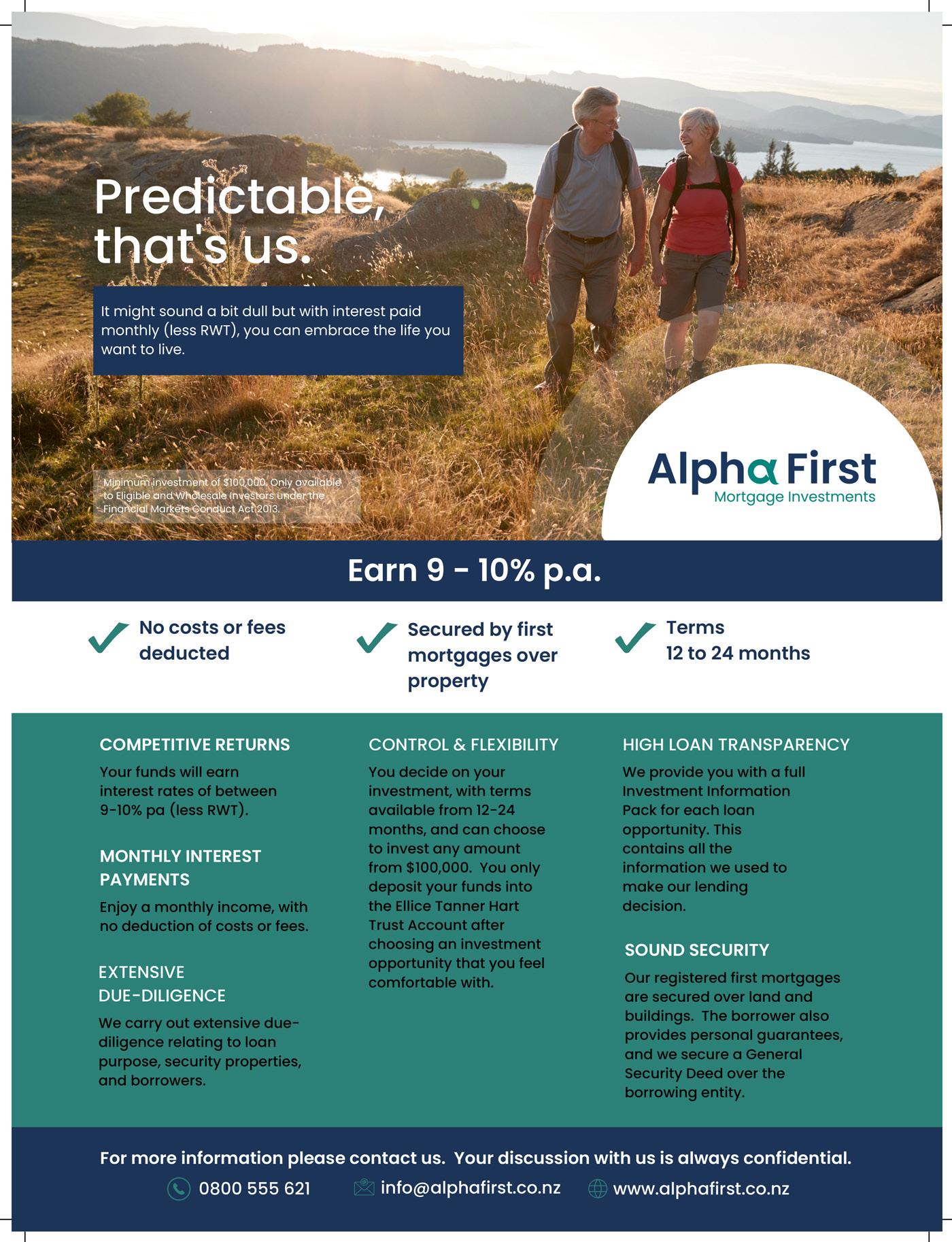
Building Your Retirement Income
Alpha First is a New Zealand-owned family-run mortgage investment firm which is proud of the way it does business.
Many experienced investors nearing retirement look for wholesale investment opportunities that will achieve sound returns at an acceptable level of risk.
They know that choosing the right investment will generate additional income and help diversify their portfolio. But when examining how wholesale investment providers operate, it’s important to know they don’t all work similarly.
Alpha First is a family-run mortgage investment firm based in Cambridge. They are 100 per cent New Zealand-owned and are proud of the key differences that set them apart.
“Firstly, we are not a managed fund, nor do we pool investor funds,” says Alpha First Mortgage Investments’ managing director, Olivia Fraser. “We are also not reliant on bank debt to fund our loans. Instead, our investors fund 100 per cent of the loan amount and receive the indicated interest rate.
“Our investors choose the opportunities they wish to invest in, so they can customise their portfolio. Some investors wish to invest in commercial developments only, while others may prefer townhouses, land subdivisions or rural land projects. Investors know exactly where and what their funds are secured over at all times.”

Monthly income
Fraser also points out Alpha First is not a finance company and does not pass costs onto investors by deduction from their interest, so projecting a monthly income is achievable.
Alpha First was founded in 2016 and presents investment opportunities that are secured by first mortgages over the borrower’s property. In turn, investors value the security of property-backed loans, the transparency around loan structure and borrower details, the monthly interest payments they receive – and, of course, the attractive returns generated. Fraser says investors have complete control over their investment decisions, and stringent safeguards are in place to ensure money is handled appropriately at all times. Law firm Simpson Grierson ensures all securities are in place, each loan is documented correctly, and investors are registered on the first mortgage over the security property. All funds are held and dispersed via Alpha First’s trust account, which is operated by Ellice Tanner Hart Lawyers.
Alpha First always takes a conservative approach to loan to value ratios and only in rare circumstances would they exceed 55 per cent LVR.
“We also ensure our due diligence is thorough so people can make a fully informed investment decision. Transparency is key and we provide a comprehensive Investment Information Pack for each loan opportunity for potential investors to review and consider.
Extra effort
“We assess a borrower’s capability, past experience, professional advisers, and their
repayment/exit strategy, and will provide further information such as a valuation report, credit report, financial trading reports, financial forecasts and works programme where appropriate. We inspect every security property and meet borrowers personally before approving any loan opportunity.”
Investors sincerely appreciate this extra effort and feel comfortable knowing every loan is thoroughly investigated to minimise risk and maximise returns.
In June, Alpha First surveyed its investors to find out how happy they are with the company’s product offering and services. An impressive 94 per cent of respondents (current or past investors) said they plan to invest again, while 6 per cent had registered but were waiting to invest1
“Results show our investors are very satisfied with our product and service, and this pleases us very much. Our personalised approach and high level of service are still seen as major competitive advantages by our investors,” Fraser says.
“We have a growing network of registered investors nationwide who enjoy the benefits of investing through us. Our team has extensive experience and deep knowledge of the industry, and we are proud of our strong track record.”
For more information on Alpha First Mortgage Investments visit www.alphafirst.co.nz or call 0800 555 621.
¹Source: Alpha First Investor Satisfaction Survey June 2023, by AFMI.
SPRING 2023 | INFORMED INVESTOR 45 ALPHA FIRST
Could Crypto Just be Getting Started?
It seems increased regulation may be the exact thing that traditional finance has been waiting for to see crypto finally mature as an asset class, writes Rupert
 Carlyon
Carlyon
It came from the outer reaches of the tech sector to land on the front pages of Bloomberg and Forbes. On its way it made a handful of institutional investors and a multitude of armchair stock pickers a fortune and then, unfortunately, lost many trend followers even more.
I am talking, of course, about cryptocurrency, the bogeyman or the saviour of modern finance, depending on who you ask. But despite all the hurrah around the digital asset class, could crypto just be getting started?
On its deathbed, not quite … At the end of 2022, following the spectacular collapse of FTX, Bitcoin fell in value from its heights of US$64,000 to depths of US$16,000, most in the finance industry (and media) thought crypto had finally been killed off.
And following the dive of FTX in November 2022, regulators and lawmakers in the United States have rightly increased their scrutiny on the crypto industry. This has led some crypto leaders to cry foul, claiming regulation would kill their industries and business models. But increased regulatory focus has done the opposite; over the past month the price of Bitcoin has hovered around $30,000, almost double its November lows.
It appears traditional finance has spent the past 12 months of the crypto winter building out new products and custody solutions to attract a whole new investor during the next uptick. This is evidenced by global behemoths like Nasdaq, BlackRock, Fidelity and Anchorage announcing new crypto products recently.
It seems that increased regulation may be the exact thing that traditional finance has been waiting for to see crypto finally mature as an asset class.
How is regulation changing the game? Crypto has coasted along for some time free from regulation, but this may be the exact thing that has kept it from maturing into the asset it always promised it could be. At its heart cryptocurrency is a technological offering; a decentralised system that moves quickly and operates without traditional borders.
For much of its life the only companies exploring the applications of crypto have done so almost completely unregulated. Any hint of regulation led to exchanges moving into more “regulatory friendly environments” or swathes of well-paid lawyers called in to argue that crypto currencies are not actually financial securities.
This has led to the catastrophe of FTX, but also a myriad of other issues the US Securities and Exchange Commission are now attempting to clean up.
US SEC chairman Gary Gensler says many crypto exchange companies made “calculated decisions” to flout the rules. In his view, most crypto tokens meet the test for being a security and so should be registered with the SEC, which also means most crypto exchanges have to comply with securities laws.
The regulator has moved to sue two of the largest exchanges, Coinbase and Binance, on this very issue.
Anyone upset at this situation is just not paying attention. If you want to hail crypto as a game-changing asset, you can’t just pick and choose which rules you want to follow and ignore the rest.
Rather than scare off investors, the increased regulatory scrutiny has encouraged some of the biggest investors in the world that cryptocurrency warrants being taken seriously.
The world’s largest asset manager, BlackRock, has this month filed to list a bitcoin ETF with the US SEC. The price of Bitcoin quickly shot up almost 15 per cent with the expectation that a new regulated product from the world’s largest fund manager would drive more demand and push prices higher.
The BlackRock bitcoin ETF is a huge about-face from the global asset manager, which in 2019 warned that only investors prepared for “complete losses” should touch cryptocurrency.
But now, by throwing its leviathan weight behind crypto, it has changed the game for everyone, and increased Bitcoin price on its way through.
Where to from here?
The only thing that has changed is now the regulators have been forced to come to the party and figure out a way to bring crypto under their remit.
It is regulation that has most probably inspired BlackRock, and it should inspire
SPRING 2023 | INFORMED INVESTOR 46 FEATURES
others to take another look at crypto, because under the auspices of the US SEC we may see the wheat cut from the chaff, the cowboys separated from the serious investors.
We may also finally get to see what this crypto thing can really do. Regulation has made the world’s largest asset manager take crypto seriously, but where will it be heading next?
In all the talk about the price fluctuations of crypto assets many forget that what we are talking about is a finite asset, especially for crypto mastheads such as Bitcoin.

When BlackRock, and the other large-scale industry players that will follow in their wake, put their weight behind crypto, it may cause a rush on the asset class. This could cause a liquidity squeeze, raising the price of the asset to heights we have not yet seen as institutional players and armchair investors try to get in on the action.
This will inevitably favour people who have
already been invested in the asset and may drive naysayers to point to crypto as overly-hyped.
But this time, with the power of large investors behind it, combined with the strength of proper regulation for the first time, there might be some staying power behind the price rise. Unlike previous price hikes, this one could be followed by less volatility.
The shape of payments, finance
Another aspect I am personally excited to see is the technological implications of cryptocurrency. While it has been an investment on the outskirts, we have had no opportunity to see what this technology can do in terms of changing the shape of payments and finance.
But if this asset class is embraced by mainstream investors, and is properly regulated as the securities they clearly are, then it will finally have the freedom and backing to achieve its technological promise.
By eliminating intermediaries through peer-to-peer transactions, cryptocurrencies could significantly reduce costs and enhance efficiency. This threatens established banking systems, necessitating their adaptation or risk of obsolescence. The borderless nature of cryptocurrencies enables financial inclusion on an unprecedented scale. Previously excluded individuals can now participate in global financial markets with minimal barriers, fostering economic growth and empowering marginalised populations. Of course, all this potential remains to be seen. But it finally feels like pro-crypto enthusiasts can stop watching the markets through their fingers in fear and can start looking towards the future with a bit of optimism.
invested. Make sure you do your research and seek financial advice before investing.
This article is intended for information purposes only and reflects the opinions of the author. Investing in
carries a significant amount of risk; you have the potential to lose all of the capital
cryptocurrencies
SPRING 2023 | INFORMED INVESTOR 47 CRYPTO
Why we Need to Ditch the Word ‘Retirement’
Changing the way we think about retirement might encourage younger Kiwis to prepare for it, suggests
Clarissa Hirst.
As 20 or 30-somethings, we know we’re supposed to plan for our retirement, but it just seems so far away.
Perhaps if the word itself conjured up a more appealing image, we’d be more inclined to look forward to it, think about it, and therefore plan for it, just like we’re being told to do.
In the name of research, I asked my friends and colleagues in their 20s and 30s what sprang to mind when they heard the word “retirement”.
One particularly financially lit person responded: “The ability to save money now so that I can continue my lifestyle when retirement comes.”
However, most answers were things like “growing old”, “not being seen as useful to society anymore” and “imminent death”, which paint a more sobering picture.
Why are retirement perceptions so bleak?

It probably doesn’t help that the word retirement itself has pretty negative connotations.
retirement, n. The action or an act of falling back or retreating from a place or position. Also: the action of receding (Oxford Dictionary).
Deriving from the French verb retirer, which means “to retreat”, the very word retire tells us that we are giving up on something: in this particular case, our lives.
Is it any wonder, then, that the average KiwiSaver balance in New Zealand at the end of 2022 was $27,379 (Retirement Commission)? As a young person, why would you save up for a time in your life when everything’s just … over? Personally, going out with a bang sounds better than gradually withering away.
German Chancellor Otto Von Bismarck could be called the inventor of the modernday retirement system. He introduced a pension for people over 65 at the end of the nineteenth century. As not many people lived to be that old in those days, the system was linked to life expectancy. Well over a century later, the retirement age in NZ remains 65, despite the fact our life expectancy has increased significantly (it’s now 80 for men and 83.5 for women, according to Stats NZ). Most of those retiring today are not on their death beds. They might be done with the working world, but they still have incredibly valuable contributions to make to society.
The idea that our contribution to society ends at 65 and it’s time to call time no longer holds true, so the way we think about retirement needs to change too.
What does retirement actually look like? Alright, so young peoples’ perceptions of retirement are all doom and gloom, but what’s the reality? As I do whenever I’m undertaking academic research for a magazine article, I turn to the most reliable source I know: my nanna.
SPRING 2023 | INFORMED INVESTOR 48 FEATURES

RETIREMENT SPRING 2023 | INFORMED INVESTOR 49
Nanna can’t really remember when she retired, but she thinks “it was probably 73 or 74”. As a kid, I remember listening to my dad talking about when she was going to retire, but she refused and kept on going until she felt she was ready. She wasn’t going to quit a job she loved just because she’d reached a certain age.
Today, she lives in her own home, toils outside in the garden, takes her cat to the vet, socialises, knocks back a glass of wine faster than I can blink, and her wit is as razor-sharp as it’s ever been. Far from “retreating” from life, she’s living a pretty good one.
For her, retirement isn’t as bad as some of my friends make it out to be, and she likes the independence. “You can do what you want, when you want, how you want,” she says. “On the whole I quite enjoy it.”
While she does miss her work from time to time, the ability to get up at 9am if she wants outweighs the downsides.
Why we need to flip the narrative
With an ageing population, there is speculation that NZ Super may not be around by the time we retire. KiwiSaver is going to be needed, and we all know that the power of compound interest means starting young will set you up for the long term.

Changing the way we think about retirement (and possibly the word itself) may encourage younger New Zealanders to save more towards it.
Right now, though, a lot of the communication directed at younger people (if I can still include myself in that category at the age of 33) is along the lines of “make sure you save as much as you can or you won’t survive!”
Negativity might get attention, but it won’t get us putting more into our KiwiSaver accounts.
Thinking about retirement in a less frightening and more exciting way might make average KiwiSaver contributions, and subsequently balances, go up.
How about we start emphasising all the exciting things people might want to do once they start exiting the world of work?
With the end of working life comes a myriad of opportunities. Whether that be travelling the South Island in a campervan, accumulating an army of puppies, having the time to work on fun projects, spending time with family and friends, getting out on the golf course, running a marathon, throwing dinner parties, volunteering, watching endless reruns of favourite TV shows, or quite simply no longer being a slave to the corporate world, let’s paint a picture of what life after work could look like.
If young people can envision a more optimistic future, maybe they’ll be more inclined to prepare for it.
So what could we call it?
Here are some alternatives to the word “retirement” suggested by the young people I spoke to:
• permanent holiday
• financial freedom
• lifetime promotion
• lifelong holiday
• freedom
• chapter two
• leisureforce
New Zealand’s Retirement Commission has adopted a te reo Māori name, Te Ara Ahunga Ora, which translates to the “pathway to developing long-term wellbeing”. I’ll take “long-term wellbeing” over “retreating” any day.
Of course, it’s difficult to think of retirement in a positive way when we don’t quite know what the world will look like when we get there and there are other factors at play like a cost of living crisis and climate change.
This article isn’t designed to solve all of these issues, but to simply shine a light on how language can play a role in the way we understand concepts.
My challenge to all the young people reading this (define “young” however you like) is to ditch the word “retirement” and get excited about saving up for your “lifelong holiday” instead.
SPRING 2023 | INFORMED INVESTOR 50 FEATURES
‘Young peoples’ perceptions of retirement are all doom and gloom, but what’s the reality?’
Health is your most valuable asset.
So why not get health insurance that’s designed just for you.
Everyone has different goals, aspirations and of course, health needs. At nib, our purpose is your better health and wellbeing, and that looks different for everyone. So speak to an expert adviser who can help tailor a health cover plan just for you. And remember to ask about our exclusive offer.*

*
To find an adviser visit nib.co.nz/adviser-plans Terms, conditions and eligibility criteria apply. Offer available exclusively through an adviser.

Artificial Intelligence:
Should we be Excited or Worried?
Over the next two decades AI may transform our world as much as the internet has done over the past two decades. But it will not make it any easier to make money on the stock market, writes
Andrew Kenningham
The launch of ChatGPT by OpenAI last year triggered a wave of optimism that artificial intelligence (AI) will transform the economy for the better. Companies which are best placed to exploit the new technologies have seen their share prices go through the roof as investors bet that they will make huge profits.

Often the hype surrounding new inventions is overdone. It is only a few years ago we were told 3D printing would transform the world, but that hasn’t happened, and self-driving vehicles have supposedly been imminent for many years now. But there is little doubt AI will make a big difference to the world in the coming decade or two. Its potential applications are almost unlimited and many have already been proven.
The future’s here
It’s worth listing a few examples. AI is expected to lead to cheaper and more accurate ways to deliver professional services. It should help identify the best pesticides for the agriculture sector, the best metals for construction, and the best compounds to absorb pollution. AI is already being used to find new uses for existing medicines and for medical diagnostics. And it is central to the design of driverless vehicles.
On top of this AI may accelerate the pace of innovation itself, because it should be able to sift through evidence faster than we mortals. And paradoxically, machines could be better than humans at “thinking outside the box”.
SPRING 2023 | INFORMED INVESTOR 53 INSIGHTS
Boost to growth
The closest historical parallel to AI is probably the ICT revolution of the late 1990s and early 2000s when personal computers and the internet were adopted. This suggests countries which fully embrace the new technologies could see their growth rate increase by 1 per cent or more per year for several years.
That said, the AI revolution will not happen overnight. It took only a few days for ChatGPT to reach millions of people but companies will not move as quickly. It takes time and money to roll out new technologies. And regulations may restrict the use of AI or the pace at which machines can replace humans.
So the benefits from AI will probably ripple through the world in the late 2020s and 2030s rather than appearing in a flash over the coming weeks or months.
What’s more, not all countries will embrace AI with equal enthusiasm. Personal computers and software were adopted rapidly in the US but more slowly elsewhere. And if anything, there is likely to be more
resistance to the adoption of AI because of the legal, ethical and regulatory concerns it raises.
Robots taking jobs?
Not surprisingly, much of the commentary about AI has focused on the risk it poses to jobs. After all, many workers and some entire professions will become redundant. Studies estimate between 20 per cent and 50 per cent of full-time jobs in the US are exposed to automation.
The job categories which are at greatest risk include “business professionals”, “managers” and “science and engineering professionals”. Even Hollywood actors fear for their future. In contrast, jobs such as “cleaner”, “nurse” and “carer” are much less vulnerable.
Nonetheless, fears of a big rise in unemployment look misplaced. There will be new AI-related roles such as for developers, supervisors, managers and regulators of AI. And AI will in many cases complement, rather than replace, existing jobs.

Also, the AI revolution will boost demand
and free up people to take on new jobs throughout the economy. This is what has always happened in response to technological progress in the past.
Winners and losers
As with any new technology there will be winners and losers. Not surprisingly, it looks as if the US will be the biggest winner while China is not far behind – though it remains to be seen how far the Chinese political system restricts the use of AI. Elsewhere, the economic benefits of AI will depend on how fully governments and companies embrace it. In the past information technology was adopted rapidly by the Netherlands, Sweden and the UK whereas southern Europe and much of the emerging world benefited less.
As for the stock market, current valuations of AI-related companies are high by any standards and reminiscent of those during the dotcom boom, which ended in tears for many. It is always difficult to predict which companies will succeed and which will fall by the wayside – and I doubt that AI will be able to help us decide.
SPRING 2023 | INFORMED INVESTOR 54 FEATURES
Flexibility the Key to Good Insurance Cover
Just because you retire doesn’t mean your need for insurance also retires.
As you age your insurance needs may change. With guidance from a network of independent financial advisers, Asteron Life’s products can provide flexible options for customers over the life of their policy.
Asteron Life recommends customers talk to their financial adviser about what options are available to them as they get older and get nearer retirement. Just because you retire doesn’t mean your need for insurance does.
Financial advice, from a professional financial adviser, can make a difference to long-term affordability of cover and outcomes in the event of a claim.
Seema Bangera, Asteron Life’s Executive Manager, Claims and Customer Solutions, acknowledges that as people get closer to retirement they’re often looking for solutions that suit their budget. Life insurance can feel like a luxury, particularly in the current inflationary environment.
“There are many options available to support affordability needs and advisers are there to tailor cover to support customers’ individual circumstances,” she says.
Speaking to a financial adviser can help customers understand and consider all affordability support options available to them.
Individual needs
The way cover is structured can be important. Asteron Life offers modular and flexible products with a range of benefits which can help customers keep their cover up to date well into retirement.

The suitability of the level of cover for any particular customer is based on many individual factors, and how much cover they require may change over time.
Premiums can be structured as either “stepped” or “level”, and this can affect the cost of cover. A stepped premium starts lower but increases each year as people get older. Level premiums can help spread the cost of the insurance more evenly over a selected term of the policy. This means premiums are generally higher in earlier years.
Customers can also choose a combination of stepped and level premium structures.
Asteron Life have options that can be tailored depending on your insurance needs through your life. Talk to your financial adviser to ensure you know your options heading into retirement.
Future-proofing cover
Asteron Life products have options that could help you future-proof your cover. On certain products there are built-in premium relief options, which allow eligible customers to take a premium holiday for
up to six months, or temporarily suspend premiums and cover for up to 12 months.
This type of flexibility can help customers keep their cover right into retirement and help support them and their loved ones. The availability of these options depends on the type of product you have. Conditions such as stand down periods may apply as well as restrictions to the number of times these benefits can be accessed, so always check your policy wording for details.
Asteron does not provide financial advice in relation to life insurance cover. This content is for information purposes only and is not financial, legal, or medical advice, nor does it offer any opinion or recommendation about whether a particular policy is right for you. You should consult a qualified financial adviser for advice specific to your personal situation and needs. Excesses, terms, conditions, limits and exclusions apply to all policies. Please check policy wording for details of cover. The provision of cover is subject to underwriting criteria that apply at the time.
ASTERON LIFE
SPRING 2023 | INFORMED INVESTOR 55
Snapshot
News, events and innovations from around the world that grabbed our attention and are likely to impact the global economy going forward.
The Russian economy shows signs of strain as its currency dropped to the lowest level against the US dollar since the start of the war against Ukraine. The ruble was sitting at 96 against the dollar, representing the effect ongoing sanctions are having on the country.
Faster than expected growth was reported for the second quarter of 2023, boosted by strong growth in the month of June. In the best quarter for over a year, the UK economy increased by 0.2 per cent, a figure that, though small, was a surprise to economists who predicted zero growth, according to Guardian reports.
Eight South American nations that have the Amazon in their territories met in Brazil in August. The aim was to come to agreement around unified environmental policies and measures to foster cooperation and stop destruction of the rainforest. A nearly 10,000-word document was created, which asserts indigenous rights and agrees to cooperate on water management, health, common negotiating positions at climate summits, and sustainable development. But it didn’t put in place Brazil’s pledge to stop illegal deforestation by 2030, or Colombia’s pledge to halt new oil exploration.
The pandemic rebound predicted for China is not coming to fruition. According to China’s National Bureau of Statistics, in August consumer prices dropped by 0.3 per cent year-on-year. It’s proof that the world’s second biggest economy isn’t growing, and this is a concern for a country with massive amounts of debt.
SPRING 2023 | INFORMED INVESTOR 56 FEATURES
RUSSIA UK BRAZIL CHINA
NEW ZEALAND UGANDA UNITED STATES UKRAINE
An anti-gay bill enacted in Uganda has led to the World Bank stating it will not consider any new loans to the country. The anti-gay legislation was signed into law in May and prescribes the death penalty for some homosexual acts. It has widespread support throughout the country. The World Bank has issued a statement claiming: “Our goal is to protect sexual and gender minorities from discrimination and exclusion in the projects we finance. These measures are currently under discussion with the authorities.”
According to Reuters, bulging warehouses and stalling demand indicate the economic downturn may last longer than anticipated. There is a flow-on effect to manufacturers, who are experiencing less orders and therefore weaker growth. The stock levels are apparently due to stockpiling during Covid-19 lockdowns, when supply chains were stalled.
A Reuters report states Ukraine’s Economy Ministry expects 5 per cent economic growth next year, driven by investment in reconstruction and stronger consumer demand. Natalia Horshkova, head of the ministry’s department for strategic planning and macroeconomic forecasting, says they expect the economy to grow around 2.8 per cent this year, with 5 per cent growth in 2024.
A new fund worth $2 billion will be used to help New Zealand reach 100 per cent renewable energy by 2030. US-based firm BlackRock has worked alongside the government to create the investment fund, which will invest in a range of projects including solar power, EV charging and green hydrogen.
Correct at Aug 10, 2023.
SPRING 2023 | INFORMED INVESTOR 57 SNAPSHOT
Why isn’t KiwiSaver Funding Infrastructure?
Unless policymakers and politicians get together with KiwiSaver managers, ever more money will continue to be invested offshore, warns Sam Stubbs, of Simplicity.
Cyclone Gabrielle has been another stark reminder of just how short New Zealand is of critical infrastructure, and at a time when the Infrastructure Commission estimates 8.9 per cent of GDP is required to be invested in infrastructure, every year, for the next 30 years.

According to their report, over the next 30 years $90 billion is needed to fix water networks. We need another 115,000 homes too. And electricity generation will need to rise 170 per cent because our population is forecasted to rise 1.2 million over the next three decades.
A further $5 billion is needed to prevent sea level rises, with a 75 per cent chance of an Alpine Fault earthquake by 2070. And perhaps most sobering, for every $40 spent on new infrastructure, $60 will also need to be spent just renewing or repairing what we already have. To do all this will require another 118,000 workers in an industry where construction costs have already risen 60 per cent faster than elsewhere in the economy.
If you believe what the infrastructure findings say, funding, building and replacing the infrastructure that we’ll need is going to be an all-hands-to-thepump affair. The Treasury agrees. Its 2022 Investment Statement puts our combined infrastructure gap at $210 billion. Interestingly, the Infrastructure Commission has been largely silent on
where this funding for all these challenges will come from. Discussion on funding our future requirements occupied only 21 of 236 pages of its final report.
Surprising oversight
And while there were well-crafted words about contribution from central government, local government and iwi, I could not find a single reference to KiwiSaver in their 68 key recommendations. This is a surprising oversight. KiwiSaver providers already have almost $100 billion under management. Add in the nonKiwiSaver funds they manage, and it could be well over $500 billion in the next 20 years. That’s 2.5-times our current GDP. Let’s remember, KiwiSaver investments are long-term in nature and 100 per cent Kiwiowned (by KiwiSaver members). Apart from government and iwi, could there be a better investor? Who wouldn’t want KiwiSaver funds investing in the ‘hood ... surely a win-win?
But over 60 per cent of KiwiSaver money is already invested overseas, and this rises daily. Why? Because there are simply not enough investment opportunities within New Zealand.
This sad reality shows the inability of politicians and policymakers to understand the potential long-term impact of KiwiSaver. They totally get it as a savings scheme, but not as a huge, domestic, longterm investor.
Here’s the irony of it all. If you told the government that 10 billionaires were arriving on a plane tomorrow, and each had $20-$40 billion to potentially invest over the next 20 years in New Zealand, ministers and policymakers would be scrambling to roll out the red carpet. And yet the top 10 KiwiSaver managers should have at least that to invest over the next 30 years. I would challenge any politician, however, to name more than three of these KiwiSaver managers.
So why is KiwiSaver investment overlooked?
I suspect the key issues are ideological and habitual. The Labour Government appears to fundamentally believe that taxpayers and ratepayers should fund the building of key infrastructure. This attitude is ironic, as it was a Labour government that founded
FEATURES
SPRING 2023 | INFORMED INVESTOR 58
the KiwiSaver scheme. Surely, Michael Cullen’s intention was that some of their investments would enable funding of future infrastructure here in New Zealand?
Once bitten, twice shy
The National Party has been only a little more enthusiastic. Their muted support is somewhat justified because most private sector co-investment in infrastructure has previously been too short-term focused, or overly complex. Once bitten, twice shy and all that. And in all cases, the only investors that could fund big-scale projects were offshore ones, which doesn’t help win votes. As soon as offshore investment is proposed, the “selling the family silver” line is invoked.
The dominance of Australian-owned
banks in New Zealand doesn’t help. They would rather lend to companies building infrastructure projects (which in turn increases profits for their shareholders), than actually work with government to invest their huge KiwiSaver schemes in infrastructure.

It all seems doomed here – and yet Australia provides a great example of how pension funds (like KiwiSaver) can and have become a major source of investment force very quickly due to the large amounts of money, and the very long-term nature of the savings involved. Surely, we could take a leaf out of their book.
The sad reality is the options for KiwiSaver funds to invest in infrastructure currently are few and far between. They can buy
more shares in the power companies or in Infratil, or invest in early-stage and small-scale “green” investments. But combined, these opportunities soak up just a small fraction of the money that could be invested. And none of this gets close to funding our massive bucket list of infrastructure requirements outlined by the Infrastructure Commission. Unless policymakers and politicians get together with KiwiSaver managers, ever more money, saved by millions of Kiwis, will continue to be invested offshore. It could be better invested in our ‘hood, for the benefit of all New Zealanders.
But it starts with recognising the opportunity and starting the conversation. I’m sure KiwiSaver managers will pay for the coffee.
SPRING 2023 | INFORMED INVESTOR 59

A Man is Not a Retirement Plan
Women need to be proactive in learning and understanding money to ensure a financially secure retirement, writes Lynda
Many moons ago, when I was growing up, I remember my dad jokingly (I hope) saying I should marry a rich farmer, and life would be good. Fortunately, mum didn’t agree, and she suggested that instead of that option why didn’t I have a career and then I could marry any occupation I wanted to.
The subtle message I received from both parents was that an important part of my financial security was to marry and form a partnership for life. I am sure there are many women of my generation, and even young women today, still getting that subtle message.
Well, I did my best, I got the career, and I did the marriage bit too. I think I got a bit carried away on that score as I gave it a go four times before finally deciding that maybe I had better rethink my plan.
I started my career as an accountant way before KiwiSaver came onto the scene, so planning for retirement wasn’t really contemplated at all when I was starting out. Security was more about buying a house and raising a family, and hubby, being the breadwinner, would look after you. So, I did that bit too, I had the house, the husband, and then my beautiful baby daughter arrived. Eighteen months later I found myself with no husband, half a house, and my beautiful toddler daughter. My financial security plan was definitely not working.
Survival mode
As for so many women who find themselves single parenting, we go into survival mode, working, often part-time, looking after our children and rebuilding our lives. Retirement is out there somewhere and if you are fortunate enough to have something tucked away in KiwiSaver you had a head start on me.
Moore.
The bottom line is it just costs more to be a woman. And no, that isn’t because we spend all our money on clothes, cushions and candles.
We live longer than our male counterparts, so we are going to spend more on living costs and medical expenses in retirement. The wage gap is always a hot topic; if you earn less that makes it harder to save. Typically, we are the one who takes the time out to raise children, so our income slows down or stops completely for a while, and if we don’t keep topping up KiwiSaver that has a big impact on how much we have to retire on.
And sadly, the rate of relationship breakups and splitting assets takes its toll as well.
So, as women what can we do. You could of course try the Man as Your Retirement Plan, but I wouldn’t recommend that as your sole strategy.
World of investment
The first thing we need to do is be not only aware but proactive in learning and understanding what we need to do for ourselves independently of our relationships to ensure we have a financially secure retirement.
What does this mean in practice?
Whether you are single, in a long-term happy relationship or a new one, you have to know what is going on with your finances. You have to know what is coming in and what is going out. Is there a surplus or are you overspending?
The world of investment may seem scary, so start small by saving what you can. I’m not a financial adviser, but there are amazing people out there who are. Find them, read the articles, listen to podcasts,
go to the workshops. The more women learn about finance the more empowered they are to feel confident in making their own decisions.
What does retirement look like for you?
Whether you are 20 or 60, get a feel for how much you need for retirement. It will scare you and maybe feel unattainable, but you need to know. Burying your head in the sand is also not a good retirement strategy. Get a plan sorted
Talk about money with your partner. Right now, the bulk of the conversations are about the price of groceries and mortgage interest rates going up. Yes, you need to be having those conversations, but also have the longer-term ones as well. You might not be able to do much about them in the short term, but at least have a plan to work towards that looks after both of you. Take responsibility for your own financial future and security.
Coming full circle back to my parents, they were happily married for 62 years before my dad passed away recently. Later, Mum and I were chatting about money, and this is what she said: “Your dad and I forgot to do one thing. We paid off our mortgage in our 40s, but instead of saving the mortgage payments for our retirement, we spent it all. We would have been so much more secure now if we had thought about retirement back then.”
I will leave you with that thought. Whatever your retirement plan is start thinking about it now.
If you aren’t sure where to start on your money management journey, head to Moneymentalist.com and come and talk to me.
SPRING 2023 | INFORMED INVESTOR 61 MONEY MENTALIST
Do We Still Have a Super Future?
Crystal ball gazing about the survival of the pension is vital for Kiwis planning their retirement, writes
Ed McKnight
Many Kiwis assume you spend your working life paying taxes, the government takes that money, invests it, and gives it back to you when you retire (through the pension).
But this is not how it works. In reality, the taxes you pay are given to people who are already retired.
So, when you retire the government will pay you with taxes taken from the working force.
Here’s the problem: We’re living longer and having fewer babies. So, more retirees than ever need to be supported in retirement, but there are fewer babies being born to support them.
This conundrum is leading some property investors to ask: “Will NZ Super still be around in 20 years?” Because, if you’re a property investor planning your retirement, you need to think carefully about whether you want to rely on superannuation (or not).


Ageing population
In 1983, the average Kiwi was expected to
live to 74. Forty years later, it’s 83 (nine years longer). In another 40 years (2063) that is expected to grow to 88 (another five years).
While that’s a good thing, it does mean retirees are becoming more expensive. Let’s spell it out.
In 1983, if you retired at 60 and died at 74 (the average life expectancy in 1983), you required superannuation for 14 years. In 2063, you require superannuation for 23 years if the age of eligibility does not change.
Too few babies
In 1957 there was a massive “baby boom”. At that time, the average female had four babies. That was great at the time because the baby boomers have been working over the last few decades and that means lots of workers to pay for superannuation.
But here’s the issue: 1958 was exactly 65 years ago. All those baby boomers are retiring this year and will be eligible for NZ Superannuation.
But now, the average woman has 1.8
babies. And fewer babies means less people entering the workforce. Currently, each retiree is being supported by four working people. This means you and three other people must pay for a quarter of a pensioner’s superannuation each. Not too bad.
But in 25 years each pensioner will be supported by an average of 2.7 people. So, each taxpayer is now paying for more than a third of a retiree’s income. This will not be affordable over the long term if NZ Superannuation stays in its current form.
Retirees are voters
But there are clear arguments that NZ Superannuation won’t be substantially changed.
Why? Retirees vote. They make up a quarter of the people who vote (not just those who say they do). In addition, people aged 45-65 make up another 35 per cent of voters. So, changing NZ Superannuation is not politically possible, and that’s not for lack of political will.
In 2011, Phil Goff tried as leader of the
SPRING 2023 | INFORMED INVESTOR 62 PERSONAL
FINANCE
Labour Party to raise the age of eligibility from 65, as did his successor David Cunliffe.
In 2017, Bill English tried when he was Prime Minister (but didn’t get re-elected). And now, Christoper Luxon wants to do it in 2023.
The Retirement Commission
The Retirement Commission (representative of retired New Zealanders) has flip-flopped on this issue.
In 2016 they came out strong, saying the age of eligibility should be raised to 67 because of unaffordability. But in 2019, they revised their stance, suggesting it should stay the same.
In 2022, they took a hard stance against raising the age even though the OECD recommended the age of eligibility be linked to life expectancy.
The Retirement Commission specifically made this recommendation because not all retirees are the same. For instance, some people reach the age of eligibility and don’t have as much wealth.
The future of Super
What actually happens to NZ Superannuation is anyone’s guess, but it is likely to be somewhere in the middle. No, it probably won’t be cancelled. But, yes, there will likely be changes.
For starters, the “age of eligibility” is likely to be raised. And at some point, some form of means testing will be introduced. Means testing is where, if you have wealth above a certain level, you might get a smaller pension or not get any government support at all.
Means testing is used (at least in part) in the UK, the United States, Australia, Belgium, Italy, Austria, Hungary and Ireland. So, it’s not without precedent. If a means test is introduced, the government might say something like: “If you have assets over $1 million, you get a reduced amount.”




Property investors beware
Crystal ball gazing about the future of the pension is vital for Kiwis planning their retirement.
If you are investing in property, and a means test is introduced, there is a good chance you might not have access to it. This will have a significant impact on your desired lifestyle because you’re unable to live on the same income you wanted.
So, if you’re a property investor and want to remove any uncertainty, plan for superannuation not to be there. That way, you don’t have to worry about whether you will have enough assets.
And if it’s still there, you’ve got a nice bonus.
New Zealand superannuation is a government-provided pension scheme for Kiwis aged 65+



Here’s how much you get per week (as of April 2023) after tax:
• $496 a week for a single person living alone ($25,811 per year).
• $764 a week for a couple ($37,744 per year).
SPRING 2023 | INFORMED INVESTOR 63 OPES PARTNERS
How to Maximise Your KiwiSaver Balance
KiwiSaver can be a powerful tool for retirement saving – so why not figure out how to maximise your balance? asks David Copson, head of growth at Booster.
With just a few tweaks to your KiwiSaver fund, you could change your quality of life in retirement. If you want to grow the largest possible KiwiSaver balance before you turn 65, here are some important factors to consider.
AGGRESSIVE FUNDS – DON’T LET THE NAME SCARE YOU OFF
The names for KiwiSaver fund types are designed to indicate the risk levels: defensive, conservative, balanced, growth and aggressive.
The word “aggressive” sounds scary, but embracing such a strategy can be an excellent choice for someone with a long investment timeframe. You might think of an aggressive investment strategy as throwing all your money into crypto or picking a few high-risk shares. But aggressive KiwiSaver funds are generally less risky than those strategies, because KiwiSaver funds are diversified across industries, countries and asset classes. On the other hand, “balanced” sounds like the perfect fund for anyone – it’s balanced, right? But for those with decades ahead of them before they need the money, a balanced KiwiSaver fund may not be the right choice. The returns will typically be much lower than an aggressive fund over longer timeframes.
Here’s a fund type comparison of projected balances at age 65 for our 40-year-old earning $100,000, making 3 per cent contributions (inflation adjusted, $70,000 balance as above), again using the Sorted KiwiSaver calculator:
INCREASE YOUR CONTRIBUTIONS – SOONER RATHER THAN LATER
The more money you contribute, and the sooner you put it in, the higher your KiwiSaver balance will be when you reach 65. Switching from contributing 3 per cent to 6 per cent of your salary can make a massive difference.

Let’s say you earn $100,000, you’re 40, you have a $70,000 balance, and you invest in a growth fund. Using the Sorted KiwiSaver calculator and its assumptions* the projected inflation-adjusted totals at age 65 look like this:
An aggressive fund usually needs an investment time horizon of about 12 years and preferably 15, so the fund allocation should be reviewed 15 years before you plan to use the money.
SPRING 2023 | INFORMED INVESTOR 64 PERSONAL FINANCE
Stay at 3% contribution from age 40 to 65 Increase to 6% contribution from 40 to 65 $340,223 $459,001
Fund type Balance at 65 Defensive $210,766 Conservative $245,994 Balanced $288,606 Growth $340,223 Aggressive $402,816
A PAY RISE IS THE PERFECT TIME TO BOOST YOUR CONTRIBUTION RATE
Automatically contributing money from your salary before it arrives in your account is one of the most painless ways to “pay yourself first”. Make it even easier by boosting your contribution rate when a pay rise kicks in, if you can afford it. Here’s what that could look like for our 40-year-old KiwiSaver member as in the previous examples, when they get a 5 per cent increase in pay from $100,000 to $105,000. Again, using the Sorted KiwiSaver calculator, growth fund, adjusted for inflation.
CONSIDER USING LEVERAGE TO MAGNIFY RETURNS

Booster has a leveraged fund, the Geared Growth Fund, which invests in the same way as our High Growth Fund but borrows to magnify returns – for better or worse. It targets a 35 per cent gearing ratio, so for every dollar you invest, you get returns of $1.35 (depending on the actual gearing ratio which can vary). There are additional costs and risks to borrowing. Over the long term the expected return of the Geared Growth Fund is higher than of our other aggressive or growth funds. Of course should losses occur, they can be higher too.
Gearing might not be for you, but it could be worth reviewing all the aggressive fund options on the market. It might just help you get the most out of your KiwiSaver account.

SPRING 2023 | INFORMED INVESTOR 65 BOOSTER
Booster is the issuer of the Booster KiwiSaver Scheme. Product Disclosure Statements are available at www.booster.co.nz. *The Sorted KiwiSaver calculator and key assumptions it uses can be found at: sorted.org.nz/tools/kiwisaver-calculator. Key annual assumptions include 4.5 per cent fund growth post tax return (28 per cent PIR), 3.5 per cent salary increase, 2 per cent inflation. For different fund categories the return assumptions differ.
Weekly take-home pay KiwiSaver balance at 65 Before pay rise: 3% contribution $1,375.97 $340,223 After 5% pay rise: 3% contribution $1,436.03 $350,141 After 5% pay rise: 6% contribution $1,375.46 $474,858 No contribution increase difference $60.06 extra per week $9,918 more at age 65 Contribution increase from 3% to 6% $0.51 less per week $134,635 more at age 65
‘The word “aggressive” sounds quite scary, but it can be an excellent choice for someone with a long timeframe for investment.’
Investing in Solutions for Some of the World’s Biggest Challenges
Innovation drives economic productivity and higher standards of living – and investing in early-stage businesses can help take local innovations from Aotearoa to the world. The Booster Innovation Fund (BIF) supports New Zealand start-ups, and gives any investor the chance to have a tiny slice of the action.
Answering some of the world’s big questions
The Booster Innovation Fund began in 2021 and has, to June 2023, achieved an impressive 23 per cent per annum return – although past performance is no guarantee of future returns. Booster co-invests with venture capital partners to take a stake in innovative earlystage businesses, by looking for companies with potential to go big on the global stage.

“We work with entrepreneurs who are often driven to solve some really important problems – such as helping industries transition to cleaner energy solutions or helping improve food security or improving healthcare access,” says Melissa Yiannoutsos, BIF fund manager. “Our investors are getting involved in these companies early as they’re beginning to spark.”
Diversified early-stage investment
Traditionally, venture capital has only been accessible to the wealthy – people with enough money and experience to mitigate their risk by investing in multiple opportunities, at least 10, and who can handle the loss if a company doesn’t succeed.
BIF makes investing in innovative businesses more accessible: it’s listed on the NZX so Kiwis can invest through an online share platform, or directly via booster.co.nz.
Some of the attractions are the fund’s size, diversification and investment approach, which spreads the risk of investing in fledgling businesses. It remains a higher-risk investment fund, but its diversification reduces an investor’s exposure to a single high-risk start-up.
PERSONAL FINANCE SPRING 2023 | INFORMED INVESTOR 66 Portfolio value by sector 1% Cash 20% Energy & clean technologies 27% Materials & technologies 21% Information services technology 31% Life sciences & medical technologies
Each company is founded on intellectual property and inventions from New Zealand’s leading research institutions or the private sector. BIF invests in robotics companies like PowerON; clean energy companies like Allegro Energy and Hot Lime Labs; healthcare companies like Alimetry and Ferronova; materials and technology companies like XFrame and BioLumic; and information services technology companies like StretchSense and Montoux.

Some of the fund’s 30 companies are showing promising signs of significant international market traction. It’s at this point Booster considers committing further funding. Other companies will ultimately wind down, but this is a natural part of investing in early-stage ventures – hence the importance of investing in a diversified portfolio, explains Yiannoutsos:
“We always think about whether a business has the ability to be a $500 million company. At the beginning they all need to have this level of potential with a credible plan to get there. Some won’t make it, and we’re starting to see that play out as well. That’s ok, because it’s an indicator we are taking the right level of risk – there’s always been an expectation that not all the
companies will make it. Investors will need patience and an understanding of risk.”
Understanding the long-term mindset
Anyone who invests in BIF will need to understand the fund’s risk profile and have a long-term mindset. It is designed to make up a small proportion of any investment portfolio, and with this in mind, the team at Booster has aimed to make it affordable and accessible. BIF is designed to have no management fees, admin fees are capped, the performance fee aligns all investor interests and it’s easy to invest in.
“It makes sense to back young companies and get in early, but investors need to be mindful that this is at the risky end of an investor’s portfolio. Investors should have a longer-term investment horizon (15 years plus), and they should only make a small allocation of their portfolio into this end of the market. You need to be patient to see the rewards of getting in early to these innovative companies.”
The success of BIF over its first two years means it is now planning to add another 10 to 20 early-stage companies to its portfolio. It’s an exciting time for the fund as it plans for expansion.
“Now we’ve been going for two years, we’re
reaching a critical mass,” says Yiannoutsos. “We established the fund with holdings valued at $4.5 million across 16 companies, and now the fund is worth more than $16 million with investments in over 30 companies. It’s still early days, however, we’re seeing some promising signs many of the companies we’re backing are building in value, are expanding their presence in international markets and securing important customers and partnerships. It’s an exciting time for more Kiwi investors to back these companies and benefit from the value creation on their doorstep.”
SPRING 2023 | INFORMED INVESTOR 67 BOOSTER The Booster Innovation Fund (fund) is part of the Booster Innovation Scheme which is issued and managed by Booster Investment Management Ltd. The fund’s Product Disclosure Statement is available at www.booster.co.nz. This article is for information purposes only. The information is derived from sources believed to be accurate as at the date of issue and may change. The content is of a general nature and does not take into account your financial situation or goals and is not financial advice. Booster, its related companies, directors, and nominees do not accept any liability for any loss or damage arising directly or indirectly out of the use of, or reliance on, the information provided in this article, nor do they guarantee the fund’s performance, returns or repayment of capital.


Looking for a long-term relationship that lasts? Our promises to you: » » » Consistency of returns Trustworthy, long-term tenants Tailored property management Find expert advice, confidence and peace of mind through a trusted Hammond & Co partnership GINA COLCORD Business Manager + 64 27 266 8367 | gina@hammondandco.nz | hammondandco.nz
Short and Long-Term Property Management at its Finest
Eric Hammond has gone from former tradie and entrepreneur to Director and Founder of The Stay Hub and Hammond & Co – two sister companies offering specialist short and long-term property management services.
In 2017, Eric Hammond turned his love for travel into a thriving business by founding The Stay Hub. Since its inception, the company has flourished as one of Auckland’s largest Airbnb and short-term property management companies. Within the space of six-and-ahalf years, Hammond watched his initial five properties expand into a portfolio of 200+ houses, apartments, holiday homes, and townhouses.
Off the back of this success, Hammond paved the way for the launch of Hammond & Co Property Management this year –complementing The Stay Hub – providing a full range of long-term property management services.
A true entrepreneur
Hammond came from humble beginnings as a tradie in the electrical industry. His
property management venture began in the early 2000s, when he couch-surfed across 47 countries and discovered the opportunities presented by short-term rentals. As successful as The Stay Hub has become, its origins began as a room-sharing arrangement in Hammond’s home where he hosted over 200 people on couchsurfing.com and Airbnb. His successful guest experience saw him referred on to other short-term rental owners looking for property management services.
As an electrician by day and property manager by night, it was obvious that Hammond’s passion for travel and short-term rentals surpassed the growth of his career as an electrician. So he left his day job and jumped into the short-stay property market. Following a series of partnerships with investors and property owners, The Stay Hub was established. From the outset, building and fostering relationships has been at the heart of the company. This has seen some of Eric’s original owners now become legacy clients who are still just as happy over six years on.
Marriott Bonvoy® partnership
In 2021, The Stay Hub’s five-star guest experience and property management standards saw it become the first New Zealand partner for Marriott International Homes & Villas. This expertly-curated platform offers luxury properties for shortterm renting to over 157 million Marriott Bonvoy ® members globally.


With his success in crafting two reputable businesses, Hammond encourages others to pursue their own entrepreneurial dreams, but recommends seeking business advice before going full steam ahead.
“My suggestion for aspiring entrepreneurs is to get good advice from a business coach or mentor.
“Early on in my story, with just five properties to my name, I mapped out a business plan
and worked with a mentor. I did many things people said I shouldn’t do – it was too early, and my business was too small. With the right knowledge and people around me, my decision to challenge the status quo is one of the reasons The Stay Hub has become so successful and led to our recent launch of The Stay Hub’s sister company, Hammond & Co Property Management.”
Hammond & Co launch
Alongside the short-term rental business, long-term property management was always part of Hammond’s vision. With the launch of Hammond & Co, the two companies offer a complete suite of property management services for homeowners and property investors. Having the ability to seamlessly switch between both markets is an attractive prospect for those who want to try short-term property management, but might want to switch back to long-term later, or vice versa. As short-term rentals are still a relatively new concept, not all property owners fully understand how the model works. Our expertise in both short and long-term property management means we can provide clients with tailored advice – and a range of solutions – to suit their needs and goals. With an ever-changing rental landscape, The Stay Hub and Hammond & Co work in tandem to ensure maximised rental returns and investment security, setting owners up to thrive from the get-go.
Visit hammondandco.nz and thestayhub.co.nz for more information.
THE STAY HUB AND HAMMOND & CO
SPRING 2023 | INFORMED INVESTOR 69


How Times Have Changed for Managing Tenancies
The increased complexity of tenancies and regulatory compliance have in turn increased the need and demand for professional property management.
Back in 2015, the property management scene was a bit more straightforward. Simple two-page tenancy agreements and easyregulations ruled the day, but how things have evolved since then. Let’s take a closer look at the key changes that have shaped the industry and made it what it is today.
Regulatory transitions
Over the years, several regulatory shifts have taken place to enhance rental properties’ quality and to safeguard tenant rights. Some of the notable changes are:
• Smoke alarms: Starting from July 1, 2016, new requirements for smoke alarms in residential rental properties were introduced, putting fire safety front and centre.
• Insulation: From July 1, 2019, all rental homes have been required to have ceiling and underfloor insulation, making them cosier and more energy efficient.
• Insurance information: As of August 27,
2019, landlords must provide insurance details in tenancy agreements so tenants are well-informed about coverage and property damage responsibilities.

• Healthy Homes standards: Phased implementation started July 1, 2021, with a deadline of July 1, 2025, when all private rentals must comply with the Healthy Homes standards, focusing on heating, insulation, ventilation, moisture and draughts.
Legislative amendments
The property management landscape has seen significant legislative changes aimed at bettering tenant rights and property standards. One of the key updates was the Residential Amendment Act in February 2021, which brought important modifications:
• Goodbye “no cause” termination: Landlords can no longer give a 90-day notice without providing a legal reason, making tenancies more secure for tenants.
• More time for property sale moves: If a property is sold unconditionally, the notice period for termination has been extended to 90 days, giving tenants more time to find a new home.
• Extended notice for owner or family moves: When an owner or their family members plan to move in, tenants now have 63 days’ notice, allowing them ample time to make other arrangements.
• Extended tenant notice: Tenants need to give 28 days’ notice to end a periodic tenancy or a fixed-term tenancy when it’s due to end, ensuring a seamless transition.
Acts every manager should know
To ace the property management game,
managers must have a good grip on various acts, including the Consumer Guarantees Act, Building Act, Health and Safety at Work Act, Human Rights Act, Unit Titles Act, Privacy Act, Healthy Homes Guarantees Act and, of course, the Residential Tenancies Act (plus all the latest updates). Understanding and navigating these acts are crucial for legal compliance and maintaining high standards.
The rise of property managers
Around 40 per cent of all New Zealand rentals are now under the care of professional property managers. The increased complexity of tenancy requirements and regulatory compliance have in turn increased the need and demand for professional property management.
Regulation on the horizon
As the industry continues to grow with the changing requirements, talks about industry regulation are gaining momentum. The goal is to bring more professionalism, consistency and protection for landlords and tenants.
The Rental Bureau has been on an exciting journey through the evolution of property management since its inception. Expanding tenancy agreements, legislative updates, and a whole array of acts have shaped our practices.
We’re committed to providing a top-notch service, maintaining compliance, and ensuring all parties have a great rental experience. With a finger on the pulse of evolving regulations we’re here to rock the property management world and create a vibrant and secure rental market for everyone involved. Thank-you for joining us on this ride.
SPRING 2023 | INFORMED INVESTOR 71 THE RENTAL BUREAU
Welcome to the Next Phase of the Property Cycle

It’s fair to say the next phase has arrived, but what might the rest of this year and 2024 have in store?
Kelvin Davidson explores the options.
On the CoreLogic House Price Index we’ve measured a 13 per cent fall in average property values from their peak so far. But the downwards momentum at national level has now almost gone, with some key areas actually starting to record increases – such as Papakura, Manukau and North Shore in Auckland, alongside Porirua, Upper Hutt and Wellington City. As such, it’s fair to say that the next phase of the cycle is here. But what might the rest of 2023 and 2024 actually have in store?
The market in numbers
First a quick recap. The initial shift in market conditions started to become clear in May, with property sales volumes rising 8 per cent from a year earlier – the first annual rise in sales in about two years. That was followed by a 17 per cent lift in June, with that rise in sales activity now starting to eat into the available stock of listings on the market, which is currently about 15 per cent lower than this time last year. New listing flows to the market each week remain very low, and that means stock isn’t being replenished very quickly. Naturally, competitive price pressures are emerging amongst buyers who are finance-approved.
But who are they? Generally, CoreLogic Buyer Classification data shows that first home buyers remain a strong presence,
with about 25 per cent of property purchases lately. Movers, or relocating owner-occupiers, are still a decent share too, at around 26 per cent (albeit that’s down on their long-term average of 29-30 per cent).
By contrast, mortgaged multiple property owners, including investors, are running at about 20 per cent – that’s lower than normal, but still a reasonable level of activity in spite of the challenges they face (e.g. 35 per cent deposits, low rental yields, loss of interest deductibility).
Which fundamentals have shifted?
The key factors driving this turnaround in sales activity and the flattening out of property prices include a generalised peak for mortgage rates, strong net migration flows, a solid labour market, and the easing in the CCCFA and LVR rules. The easing in LVR policy has already helped more low deposit investors into the market, such as those with 35-40 per cent deposits who were previously locked out.
Associated with those key drivers I suspect the “mood” has changed too, with previous fears of paying too much for a property now giving way to concerns that prices might slowly move out of reach again for some buyers. Psychology always plays a key part in the housing market.
Downturns and upturns
Depending on your perspective, you may either celebrate (existing property owners) or commiserate (would-be first home buyers) the end of the downturn in prices. But I still have a fairly cautious view of where the market heads next. After all, even after the recent falls in property values, housing affordability generally remains stretched – and given our continued inflation problem, mortgage rates don’t seem likely to fall much for at least another nine to 12 months.
In addition, there remains a fair possibility that the Reserve Bank will introduce formal caps on debt-to-income ratios for mortgage lending in the first half of 2024. These will tie long-term house price growth more closely to incomes, and effectively limit how many properties an individual can own in the short term (until their income has had time to grow sufficiently to allow another purchase).
To my mind, although house prices will probably drift higher over the next 12-18 months in many parts of NZ, the growth may well be slow and come in fits and starts. For property investors, clearly the looming election will be a key milestone – with a possible National-led government looking set to reinstate interest deductibility for existing properties.

SPRING 2023 | INFORMED INVESTOR 72 PROPERTY
Average Property Value
CoreLogic House Price Index
Percentage change last three months
-2.4%
$911,222
New Zealand
SPRING 2023 | INFORMED INVESTOR 73 CORELOGIC West Coast $364,301 1.2% Southland $463,925 3.2% Auckland $1,267,954 -4.0% Bay Of Plenty $880,841 -3.6% Northland $735,097 0.9% Waikato $795,612 -3.1% Gisborne $595,293 -2.4% Wellington $883,752 -1.8% Hawke’s Bay $731,809 -0.6% Taranaki $ 641,179 0.2% Canterbury $705,922 -0.7% Marlborough $690,901 -1.2% Otago $857,904 -0.1%
Average
Manawatu/Whanganui $547,482 -2.0% Tasman $780,442 -3.9% Nelson $786,320 -2.8%
Shining a Light on Commercial Property Funds
Property investment is popular but finding a deposit and the management and maintenance might put you off. Rich Lyons shares an alternative.
Kiwis have long favoured residential property as their go-to investment and a means of securing their financial future, believing it’s “as safe as houses”. But for some, owning a property – whether to live in or as an investment – is out of bounds due to the hefty deposit, high levels of maintenance, or both.
That doesn’t mean you should rule out property as an investment option altogether. While not as widely understood as residential investment, unlisted commercial property funds also provide investors with a similar tangible, bricks and mortar investment, minus the admin and high barriers to entry.
In a nutshell, investing in an unlisted property fund allows investors to buy commercial property in “bite-sized” amounts alongside other investors.
“As far as investment strategies go, commercial property is a long-term play and has the potential to deliver strong investment returns over time, while also providing the opportunity to be paid monthly cash distributions,” says Rich
Lyons, retail investment manager at Oyster Property Group.
Oyster Property Group is one of New Zealand’s leading unlisted fund managers and has been providing retail and wholesale investors with access to quality commercial property investment options, and consistent returns for over 20 years.

With $1.9 billion in assets under management, Oyster’s experienced team of property experts purchase quality properties of significant scale in the office, industrial, and large format retail sectors, which are then managed in-house by a team of dedicated property managers with deep knowledge of the sector.

The firm operates an active fund management strategy, and an in-house investment relations team provides a personalised service to investors.
Working to a robust buying criterion, Oyster looks for commercial properties in sought-after locations, close to amenities and transport links, where appropriately zoned land is in tight supply.
“Our overall investment philosophy is to target quality commercial property that has enduring occupier demand, is well located and close to amenities, and has reputable tenants,” says Lyons.
“We buy quality properties in asset classes with robust long-term outlooks.
“We’re proud to provide thousands of New Zealanders access to both wholesale and retail investment opportunities that offer long-term investment returns, backed by strong fundamentals and the resilience of the commercial property asset class.
“Investment
stability is a big drawcard.
Commercial property has proved to be defensive during periods of major economic instability generally and isn’t subject to the same sentiment-based volatility investors can experience in the share market.”
20 years delivering value
That’s not to say that commercial property is immune to economic downturns. Like other investments it has been impacted in the current economic environment.
PROPERTY
SPRING 2023 | INFORMED INVESTOR 74
Accumulated total returns by investment type
Oyster Divestments – Single Asset Funds1
NZX502

Term Deposits3
The data show Oyster investments during the 20-year period outperformed cash term deposits over the long term by more than two-fold.
1 The realised total returns (realised income return plus realised capital return) represents a simulated total return to a hypothetical investor who purchased each of Oyster’s single asset funds that were unwound through the sale of the underlying commercial properties (earliest fund inception in 2003) with an even weighting across the funds.
2 The realised total return for the Smartshares NZ Top 50 ETF (FNZ). Source: smartshares.co.nz
3 The realised total return for new interest-bearing 6-month term deposits. Source: rbnz.govt.nz All income returns are not compounded, and all returns are before tax. Past performance is no indication or guarantee of future performance. All investors are recommended to seek professional advice from a financial advice provider which considers their personal circumstances before making an investment decision.
2003 2005 2007 2009 2011 2013 2017 2016 2014 2020 2022 2004 2006 2008 2010 2012 2015 2019 2018 2021
OYSTER PROPERTY GROUP
‘We’re proud to provide thousands of New Zealanders access to both wholesale and retail investment opportunities that offer long-term investment returns, backed by strong fundamentals and the resilience of the commercial property asset class.’
Realised total
return
250% 200% 50% 0% 100% 150%
300%
SPRING 2023 | INFORMED INVESTOR 75
Office business park, Central Park Auckland, a joint venture with a capital partner and Oyster Property Group
“Our ultimate focus is the delivery of long-term investment returns to investors, and we’ve got a proven track record of delivering this,” Lyons says.
“Oyster has been operating for more than 20 years, during which time we have successfully navigated multiple economic cycles to deliver consistently strong outcomes for our investors.
“This has highlighted the importance of taking a long-term stance on commercial property.”

The data speaks for itself. As the graph shows, Oyster investments outperformed cash term deposits over the long term by more than two-fold over a 20-year period.
“While listed investments have delivered a higher aggregated total return, they are often more sensitive to economic factors due to sentiment driven pricing, meaning the timing of realising an investment can
severely impact total returns,” Lyons says.
“This volatility is illustrated by the global financial crisis from mid-2007 to 2009 and the start of the Covid-19 pandemic in 2020.
“This performance has been supported by our ability to manage the entire property lifecycle in-house, from transactions and real-time fund management to hands-on asset and facilities management, providing us with enhanced capabilities to actively manage risks and opportunities as they present themselves.
“Our learnings over the past 20 years, particularly during times of volatility, inform the strategy we are applying today as we manage the pressure caused by the current economic environment while laying the groundwork for the next cycle.”
To learn more about Oyster Property Group, visit www.oystergroup.co.nz.
PROPERTY
‘As far as investment strategies go, commercial property is a long-term play and has the potential to deliver strong investment returns over time, while also providing the opportunity to be paid monthly cash distributions.’
SPRING 2023 | INFORMED INVESTOR 76
Oyster property fund, Millenium Centre, Ellerslie
Welcome to Cutting-edge Technology with a Personal Touch
Keyhook has rapidly gained popularity among thousands of Kiwis who are seeking a more efficient and effective way to manage their rental properties.

Searching for an efficient and cost-effective way to manage your investment property?
Look no further than Keyhook, the innovative new app that’s challenging the status quo and reshaping the property investment market.

Keyhook has rapidly gained popularity among thousands of Kiwis who are seeking a more efficient and effective way to manage their rental properties. Available on web and mobile platforms, Keyhook leverages automation to handle most property management tasks, streamlining processes and saving you time and effort.

The key to Keyhook’s success lies in the dedicated human support element that sets it apart from other faceless apps and softwares. Keyhook’s support and maintenance teams take pride in delivering personalised service around the clock, seven days a week, building a strong relationship with you as a landlord. They understand your property and tenants, and work alongside you and your tenants to ensure a smooth and successful rental experience.

Big savings
In today’s market, with rising interest rates putting pressure on property investors, every dollar counts. Many landlords using traditional property management have found themselves struggling to cover mortgage payments due to high management fees. Keyhook offers a solution to this problem, saving landlords over $2,000 per year in management fees (based on 8 per cent of the median rent in Te Aro, Wellington).
Smart alternative
While Keyhook acknowledges the place for
traditional property management, it aims to offer an alternative that utilises technology to reduce the time and effort associated with managing a rental which has not been available until now.
With Keyhook, landlords can confidently and efficiently self-manage their properties from their smartphones, using an intuitive, proactive and innovative app. This innovation has been most recently showcased through “Tama”, Keyhook’s AIchatbot that specialises in answering queries relating to New Zealand tenancy law and legislation. This groundbreaking tool has already garnered immense attention, with hundreds of users flocking to it within the first 24 hours of release.
Tama’s real-time learning and improvement capabilities have exceeded the expectations of Keyhook’s team, providing landlords with invaluable support and guidance.
Investment opportunity
The Keyhook team’s commitment to excellence has resulted in remarkable success and rapid growth throughout New Zealand in a short time. To capitalise on this momentum, they are raising capital to invest in expanding their services and offerings. Moreover, Keyhook has been approached by international markets and is actively exploring setting up operations overseas to meet this demand.
Keyhook has proven product market fit, and the property market is ripe for disruption.
Keyhook is not just another property management app; it is a game-changer that combines advanced technology with a human touch to redefine the property management experience.
With Keyhook anyone can enjoy seamless automation of tasks, significant cost savings, and be supported by a team of experts every step of the way. Join the growing community of satisfied landlords who have already embraced Keyhook and experience the future of property management today.
Say goodbye to the old ways and embrace the future with Keyhook, where innovation meets personalised service to empower landlords like never before.
Sign up now and revolutionise your property management journey!
Download Now keyhook.com keyhook.com Download now (5.0) (4.9) KEYHOOK SPRING 2023 | INFORMED INVESTOR 77

Retire Early with Short-Term Rentals
Airbnb income can help pay off a mortgage faster, bring another investment property closer, or reduce personal loans to reach financial freedom, writes
managing director
Stefan Nikolic
Short-term rental properties (aka Airbnbs) can provide you with a substantial income over and above regular long-term rental rates, so this can be a great way to help you on your journey to financial freedom in multiple ways.
1. Serious side hustle
If you purchase an investment property and are keen to be hands-on, then managing the property as an Airbnb will give you far higher returns than renting the property to a tenant. Short-term rental only works well for certain properties, so it’s best to do your research and have a plan before you make an investment purchase.
In general, income from a short-term rental will be about 50 per cent higher than longterm rental income after management fees. If you manage it yourself, you should earn even more if you can match a professional manager’s performance.
If you have a full-time job and find yourself too busy to do everything, then you can find good contractors to help you manage the day-to-day running of your new side hustle, such as messaging guests promptly, fixing maintenance issues, cleaning the property and the check-in process. You can find students to help you via Student Job Search for example – they are usually smart people and often located in the central suburbs, so doing check-ins and cleaning shouldn’t be too much of a problem for them if your property is also centrally located.
You can then use the extra income from your Airbnb to either pay off your mortgage
faster, save up for another investment property, and/or pay down any personal loans you may have to get you closer to financial freedom. Once you’ve paid down your debt to a more comfortable level you can hand the property over to an Airbnb property manager to keep it going so you don’t have to be involved any more, or just switch it to a tenancy for a more regular and predictable income stream, albeit with less income overall.
2. Rent your spare room
If you don’t own an investment property but do own your own home, then you can rent out a spare room on Airbnb or other similar websites to add a little extra to your income. Again, you can use this extra income to pay down any debt you may have, such as your home loan or other debt, or invest the money into another asset to help you move towards your financial goals quicker.

Although some may not be comfortable with the idea of having a guest in their home, most guests using Airbnb are pleasant people and are just keen to experience a new culture and way of life. This is your chance to show them how amazing NZ is! Also, remember you don’t have to rent your spare room out forever – it may be only for a few years as a temporary step to get you closer to financial independence.
You’ll still have to message guests, clean the room in-between stays and make sure there is a reliable check-in method etc but you’ll have full control over when your room is available for Airbnb guests by blocking off or opening the online calendar when you
want a booking. If your room or property is advertised correctly, then you should receive bookings quite soon after opening the calendar so you can control how much extra income you make from this.
3. Hands-free investment
Just like with regular property management, there are short-term rental management companies like Zodiak that specialise in maximising the return of property for you. With years of experience, we have the data and knowledge on how to optimise performance and can even help you with selecting the perfect property for short-term rental from the start. By handing over the property to a professional manager, you can rest assured you are maximising the return of your investment, without needing to become an expert or doing the work yourself.
Professional managers will do all the work for you so you can enjoy retirement without having to worry about the property. Airbnb management companies in Auckland tend to charge anywhere between 12 and 20 per cent for their management fee, but it pays to do your research and find a trusted company with a proven track record (cheapest is not always best).
To find out more about the Airbnb market and short-term rental topics, you can read our blog where we post new content every week – check it out at zodiak.co.nz/our-blog
Zodiak Management: zodiak.co.nz; 0800 333 325; email: stefan@zodiak.co.nz

SPRING 2023 | INFORMED INVESTOR 79 ZODIAK MANAGEMENT
SPRING 2023 | INFORMED INVESTOR 80 PROPERTY
What Can You Spend in Retirement?
Retirement is often more expensive than people realise. Think of it like this: It’s the weekend … every day. Here’s what life on the pension looks like for many Kiwis, Andrew Nicol writes.
If you turned 65 years old and retired today, living solely on superannuation, you’d have $764 bucks to live off next week.
This is if you had a spouse or a long-term partner. If you were flying solo, you can expect $496 a week.
According to a new report released by Massey University, you’ve got to spend $202 for compulsory household expenses. These are things like rates, insurance, and electricity.
Assuming you’ve paid off your mortgage in full.
This leaves $561, a week, to cover: Food, holidays, weekly wine and dine, and presents for your grandkids.
No, it’s not a lot of money.
Retirement is expensive
And here’s the other thing – retirement is more expensive than what you’re used to spending in an average week.
Why? It’s the weekend. Every day.
Now think about what the average person does on the weekend.
Do you: Spend time with your family? Have a beer with a mate? Go to a sports game?
The bottom line is you’re likely to spend more on the weekend compared to working 40+ hours a week.
It’s the same thing for retirement.
SPRING 2023 | INFORMED INVESTOR 81 OPES PARTNERS
What can i spend?
Massey University’s report did attach a budget for what to spend on the essentials when this is your weekly wage.
Here’s what those allowances look like (for two people):
Fruit and vegetables. Total allowance: $18 a week
If you’ve set foot in a supermarket recently, you don’t need me to tell you how expensive fruit and veg are.
If you’re conservative, you can enjoy a handful of essentials:
But if you like celery or cauliflower – you’ll barely afford three items.
Alcohol. Total allowance: $12 a week
If buying your booze at the supermarket, you could afford the cheapest bottle of wine ($7.90) or a single bottle of cider ($6.49) … but you couldn’t buy two.
But the cheapest six-pack of beer (Haagen) is $14 … so beer drinkers miss out.
Going out is a different story.
At Auckland’s waterfront Soul Bar, $12 might scrape you a “one sip” cocktail. But that’s it.
You’ll miss out on a bottle of Corona by $1.
Culture and recreation. Total allowance: $28 a week
If you want to enjoy some live events – like a sports game, a concert or the opera –you’re going to have to be very savvy when it comes to saving.
Sure, the cheapest ticket to the league in two weeks is $20 each.
So, if you save your allowance for two weeks, you’ll be able to go with your partner.
General admission to the Foo Fighters in January 2024 is $220.90 a ticket. You’ll be saving for 15.7 weeks.
Other allowances
Massey’s list covers some other essential items a retiree will need. But the outlook is just as grim.
For restaurant outings, you’re afforded $25 a week.
For clothing, the budget is $9.30 a week. But shoes don’t make the cut. Your allowance for shoes is $0.
Super won’t cut it
These bleak budgets are the reality of life for a significant number of Kiwis. It’s not the kind of money you can live a luxurious lifestyle on. In reality, superannuation is likely to fall short.
According to Massey’s report, it costs $930 a week to live a no-frills lifestyle (the cheapest of cheap budgets).
Superannuation was $764 a week, which meant you were already short $166 a week
if just living on NZ Superannuation. Kiwis need to do something to make up for the shortfall. This could be savings, or investing in shares. Or it could be property investment.
Invest to retire
Investing is expensive. Properties are expensive. And it can curb some of your spending that you would like to do … right now. It may cancel a Sunday brunch or two, or it might mean missing out on the new sports car this year.
But spending that money now will impact the money you can spend later on.
So, there is a trade-off.
Build more wealth now to live a better retirement in your future or live a better life now, and prepare to live on a strict budget later.
One way or another there is a sacrifice, either now or later.
SPRING 2023 | INFORMED INVESTOR 82 PROPERTY
‘For clothing, the budget is $9.30 a week. But shoes don’t make the cut. Your allowance for shoes is $0.’


What’s for sale. What
Discover thousands of property listings right across the country and FREE estimated values based on the very latest sales figures. Download the FREE app.
it’s worth.

SPRING 2023 | INFORMED INVESTOR 84
Boomer or Bust? The Looming Trillion-Dollar Investment Question
Over the next three decades, New Zealand will see a transfer of wealth like never before as our baby boomers decide what to do with a lifetime of accumulated wealth.
Timing, as they say, is everything – and this generation has been uniquely well-positioned for economic prosperity. Their journey to financial wealth has been supported by high rates of home ownership – and their further reward for reaching this destination has been a non-means-tested system of superannuation and benefit payouts. This is not to suggest it’s all been done without hard work and sacrifice, but you need to have the luck first to be able to ride it.
Baby boomers may be the lucky generation, but they’re not immortal. They could, of course, seek to go out in a blaze of spending glory. But according to Matt McHardy, general manager of investor relationships at PMG Funds, most older Kiwis will recognise the role that luck and timing has played in their wealth generation – and will see themselves as its custodians for future generations, rather than its owners.
“It’s like the saying about the planet: We don’t inherit it from our ancestors, we borrow it from our children,” says McHardy.
“If we think of it in terms of kaitiakitanga, these elders are now well set to leave an enduring legacy – and where this wealth is secured in assets like managed funds, they can still enjoy the benefits of reliable income while protecting the capital base from which it’s derived.”
Trillion-dollar transfer
McHardy estimates that globally the baby boomer generation will be transferring around NZ$100 trillion to their kids over the next 30 years.
“Done right, the wealth that is built by one generation can help to improve the quality of life for many generations in the future,” he says.
McHardy cites PMG’s own investor make-up as evidence of this custodianship of wealth and financial smarts in operation. Now in its 31st year, PMG has fourth-generation investors from the same family – in some cases with all four generations investing simultaneously as parents or grandparents have opened investment accounts for children as young as six months old.
Gifting smarts and wealth
The transfer of wealth is by no means a one-dimensional transaction – and making sure future generations understand the role they themselves must play as custodians is another vital part of the wealth-building puzzle. If older family members are reluctant to discuss money, it can mean younger generations inherit wealth without having any idea of how to take care of it. There are a range of independent sources, both real and virtual, that can aid these conversations and help bridge the generational divide when it comes to giving and receiving advice.
“Apps and tools like SquareOne and Sorted.org.nz can help even the very young learn how to manage their pocket money and develop good habits early; and gaining this foundation knowledge will ultimately make introductions to the professional support network of financial advisers, lawyers and accountants feel less daunting,” says McHardy.
Research by the Reserve Bank of NZ has shown high school financial education classes lead to higher savings rates and higher net-worth-to-earnings rates as an adult. PMG is passionate about improving financial literacy among future generations of investors and through the PMG Charitable Trust has helped deliver tens of thousands of programmes to Year 10 students nationwide to build financial literacy among young Kiwis.
What if you won’t inherit?
There’s no doubt the late alphabet generations that followed the baby boomers have had – and will continue to have – it tougher, says McHardy. Furthermore, not all baby boomers will have taken advantage of their good timing, meaning there will be many Kiwis out there setting off on their own investment journey from a standing start. Those who don’t stand to benefit from a legacy must shoulder the responsibility of building and protecting wealth for their own children. And although buying houses may now be much harder, the good news is other types of assets are becoming more accessible than ever.
“There are still ways to grow your wealth without necessarily owning a house or inheriting a large sum of money from a parent or grandparent. The DIY investment platforms such as Sharesies, InvestNow and GoalsGetter are a fantastic way to learn more about investing – and can provide access to investment products and managed funds with low entry points, like our Generation Fund which starts from $1,000.”
No matter what your starting point, it takes conscious steps to ensure a lifetime of hard work can continue to pay off. Despite it becoming harder, it is still possible for Kiwis to support their own financial wellbeing and help ensure successive generations have the flexibility and freedom to decide when, rather than if, to retire and choose what life in retirement looks like for them.
Visit pmgfunds.co.nz for more information on PMG’s products and investment options. SPRING 2023 | INFORMED INVESTOR 85
PMG Disclaimer: The information in this article is of a general nature and was current at 10 August 2023. It is not intended to be regulated financial advice for the purpose of the Financial Markets Conduct Act 2013, and does not take your individual circumstances and financial situation into account. PMG does not provide financial advice. Please seek advice from a licenced financial advisor before making any investment decisions.
PMG Funds’ Matt McHardy speaks to Informed Investor about the responsibility that comes with the great Kiwi wealth transfer.

Cellar Door on the Doorstep
Somm, Shed 22, Princes Wharf. Open Tuesday-Wednesday from 3pm till late; Thursday to Sunday from 12pm till late. See sommcellardoor.co.nz for details.
When you think “cellar door” it’s likely certain images will spring to mind: cycling around Wairarapa from vineyard to vineyard or driving amidst vine-covered hills to delve into the historic cellars of Champagne. Cellar doors are a delight for wine lovers, but a visit usually means travel, which for many happens only once or twice a year.
Somm, located on Auckland’s Princes Wharf, provides Aucklanders (and visitors) with its first urban cellar door. Established as a showcase of New Zealand’s finest wines, it also offers an excellent food menu that has been created by executive chef Gavin Doyle, from sister establishment SOUL Bar and Bistro. And best of all, Aucklanders don’t have to travel outside the city to sample the delights.
Somm (named after the word sommelier or wine steward) is located behind an unprepossessing door at the heart of the harbour precinct. It may not look exciting, but on entering Somm you are greeted by a Nott Architects' interior fitout – all oak and walnut timbers, stone and clay, reflecting the materials you may find in a New Zealand winery. It’s dark and delightful, warm and rustic, with luxe overtones.
Flights of fancy
My two companions and I are led to a low table with comfortable chairs, and one of the waiting staff explains how Somm works.
Somm represents wines from Hawke’s Bay, Martinborough, Marlborough and Central Otago. The wine curious can order “wine flights” – four glasses from different regions, or varietals. This is possibly their “signature” offering, but there’s also an extensive bythe-bottle wine list, plus beers, cocktails and champagne.
The three of us chose different “wine flights” – I decide on drops from Hawke’s Bay, my partner opts for the Central Otago flight, and my friend chooses sauvignon blanc.

These flights are swiftly presented on cardboard, with the wine’s name and helpful tasting notes. Ranging from $29 to $55 for four tastings, you can get a real sense of the style of each vineyard and the characteristics of each variety.

Raising a glass
My favourite from the Hawke’s Bay flight was the 2020 Church Road Grand Reserve Chardonnay, an award-winning wine with flavours of roasted stone fruit and wood tannins.
It’s also a sentimental favourite, for this was the dinner wine choice of my much beloved (now sadly departed) stepmother and (as flavours can do) brings back wonderful memories.
We decide that eating is a good idea, so order. This included a sharing plate (Jersey cow halloumi with parsnip, apple, honey and hazelnut), market fish ceviche, and 72-hour polish dough potato, truffle, thyme and smoked-brie pizza. They are lovely and represent the overall vibe of Somm: unpretentious, local, and perfectly crafted.
The service at Somm is excellent and the low-lit, warm, wood-and-earth interiors the perfect location for a long winter’s night.
I asked my party to rate the place out of five – they all gave it a 4.5 rating. The only downfall was the table’s location by large glass doors (it was a little chilly). We agreed it was worth a return visit.

Somm is a lovely spot to sample some of New Zealand’s most exhilarating exports and sup the cares of the day away.
- Reviewed by Joanna Mathers
SPRING 2023 | INFORMED INVESTOR 87 RESTAURANT REVIEW
Can You Have it All with a Compact SUV?
High-end compact SUVs have an international taste, from German, to English and Japanese, and now you can add some Italian to the smorgasbord thanks to Maserati’s all-new Grecale.

And to continue the international flavour, Grecale is named after a north-easterly Mediterranean wind.
Seven years ago, the luxury Italian brand launched its medium SUV, the Maserati Levante, and now it has added the Grecale to its range to attract a new buyer.
At Maserati they call the Grecale the “Everyday Exceptional” meaning it can be used on a day-to-day basis in luxury and comfort, all while having plenty of performance on tap. And performance is something Maserati says should be a part of your daily routine.
Maserati would be looking to nab buyers who would have been customers of BMW, Mercedes-Benz, Porsche, Audi, Jaguar and Lexus.
To do this, Maserati created a stylish compact SUV that has European charm, timeless design and the brand’s famous trident proudly centre of the grille.
It is an SUV with generous dimensions; 4,846mm long with a wheelbase of 2,901mm, a height of 1,670mm, a width of 2,163mm (including wing mirrors). With a rear wheel track of 1,948mm (which becomes larger in the Trofeo), it has a distinctively sporty appearance.
Although sitting in the compact SUV segment, the Grecale can fit five adults (though the middle rear passenger has limited foot room due to the transmission tunnel running through the vehicle).
The Grecale boasts an impressive set of best-in-class features, including spaciousness and comfort, driveability, handling, acceleration (0-100kph in 3.8 seconds – on the Trofeo) and top speed 285kph (again on the Trofeo).
It offers a wide range of powertrains, including conventional internal combustion engines, hybrids, and in the future, fullelectric options. The new SUV provides a unique blend of luxury, performance, and style, while also being an everyday car that can be used for commuting or family outings. Designed to deliver exceptional performance, the Grecale has features like an advanced all-wheel-drive system and air suspension standard on the Trofeo providing excellent handling and a thrilling driving experience.
Versatile and practical
Grant Barling, general manager for Maserati NZ says, “The Grecale is an SUV that offers exceptional performance and luxury, combined with versatility and practicality. We are excited to introduce this model to the New Zealand market and believe it will be well-received by Maserati enthusiasts and new customers alike.”
The Grecale is currently available in New Zealand in three versions: GT (priced from
$124,000), Modena ($145,000), and Trofeo, with a full-electric version, Folgore, recently revealed at the Shanghai Auto Show. We tested the $186,000 Trofeo after spending time in the entry-level GT and the top-spec Grecale ups the power, performance and handling.
The Trofeo boasts a 3.0-litre twinturbocharged Nettuno V6 which is used in Maserati’s MC20 sports car. Power is 395kW while torque is at 620Nm. It is paired with an eight-speed automatic transmission.
It has five driving modes: off-road, comfort, GT, sport and corsa. The two latter ones stiffen handling and steering, while they hold the gears for longer than in comfort or GT mode. For example, I dialled in sport on the motorway, and it was still in fourth gear when I hit 100kph.
With corsa mode, all driver assistant functions, such as lane keep assist, are cancelled, so this makes it great if you want to do a track day in the Grecale Trofeo. Even better, just think what it would be like driving on autobahns with no speed limit. Corsa mode also offers the driver the most extreme experience; the pedals are highly sensitive and responsive. The gear change is faster while traction control is less active and launch control is switched on.
SPRING 2023 | INFORMED INVESTOR 88 INVEST IN YOURSELF
The Maserati Grecale Trofeo’s ‘Everyday Exceptional’ label describes it perfectly as Liz Dobson discovers.
Off-road? No problem
The Trofeo has an off-road mode to improve all-terrain performance and driving control, efficiency is slightly reduced compared to the comfort and GT modes. The gear change is gradual. The rev-limiter is activated and the driving height is set to “high”, +20mm. I don’t expect to see a lot of Trofeo owners towing boats, horse floats or taking the trailer to the rubbish trip, instead think of field-side at the polo.
Add all the style and engine features together and you realise the Trofeo was created by Maserati with a focus on performance while providing comfort. Maserati says the Trofeo is suited to sports enthusiasts “who consider it in terms of performance and a constant personal challenge”.

I considered it a highly desirable everyday drive, with the bonus of tremendous power when needed.
The Trofeo also has materials focused on high-performance, such as exposed, threedimensional carbon fibre and perforated leather, paired with chevron motifs that emphasise the car’s dynamism.
Inside the quiet cabin, the Grecale has a touch-based interior, featuring various displays for easy interaction. The car boasts a digital cluster, a 12.3” central infotainment
screen – the largest ever seen in a Maserati – and a smaller 8.8” comfort display with extra controls and a new digital clock face. The car also features the latest in technical innovation, including the Maserati Intelligent Assistant (MIA) multimedia system, and the heads-up display, available as an option.
The Trofeo also has 21” alloy wheels, specific sports exhausts and carbon fibre inserts on the front and rear bumpers, and on the side skirts. The large tyres make for a firmer ride and it is susceptible to bumps in the road, but you can lower the car to help with aerodynamics.
And there is also the opposite, you can raise it to two levels in off-road function to help you navigate gnarly roads.
Love that noise
Inside, the Trofeo has 360-degree sound, so you can hear the roar of the engine and the Sonus Faber audio system features 3D sound and up to 21 speakers.
Talking of that noise, the V6 engine is delightful when you do a quick upchange of gears at speed. Moving from fourth to sixth gear, as I did a quick manoeuvre on the motorway, the exhaust gave a delightful blip sound.
In sport mode, when there is a gear change
down at speed you get the crackle from the exhaust.
Sure, when you start up the Trofeo, the V6 engine will growl for a few seconds as it wakes up, and yes a tap of the accelerator while in park mode will emit a few more crackles – much to the delight of fellow car fans, or to the disdain of your neighbours. The Grecale overall is a stunning-looking SUV, that has an exterior similar to its main competitor, the Porsche Macan. What about the Grecale Trofeo competition?
The Macan GTS is equal when it comes to performance while Merdeces-AMG’s GLE 63S also lines up alongside the Italian car. BMW joins in with the X5 M, Audi has the SQ5 and Japan’s Lexus RX is added to the performance SUV category. And let’s not forget the British Jaguar F-Pace SVR. While the Trofeo is built for everyday performance, there is a downside; it’s thirsty. I averaged 13.8 litres/100km although I had tested it in sport and corsa mode and driven it hard on the motorway. But even driving in comfort mode sees the fuel tank depreciate quickly.

If you are looking for a luxury compact SUV, then I recommend you add the Grecale to your shopping list.
Ciao!
NZ SPRING 2023 | INFORMED INVESTOR 89 MOTORING
‘I considered it a highly desirable everyday drive, with the bonus of tremendous power when needed.’
Photos: Maserati
Fashion Update




The fresh styles of spring.



 8.
1.
7.
8.
1.
7.
SPRING 2023 | INFORMED INVESTOR 90 INVEST IN YOURSELF
1. Mykita Lite Nukka sunglasses – $910, 2. COS Knitted Silk Polo Shirt – $115, 3. Levi’s 568™ Stay Loose jeans – $179.90, 4. R.M.Williams Hawkesbury holdall – $799, 5. R.M.Williams Highland Blazer – $479, 6. Allbirds Wool Runner – $210, 7. Levi’s Alameda button down shirt – $149.90, 8. R.M.Williams Bourke shirt – $179








 1. twenty-seven names Just Desserts blazer – $750, 2. Ahem Point Mirabeau glasses – $890, 3. twenty-seven names True Blue shirt,
1. twenty-seven names Just Desserts blazer – $750, 2. Ahem Point Mirabeau glasses – $890, 3. twenty-seven names True Blue shirt,
FASHION
4. Kathryn Wilson Dolly Heel – $329, 5. COS pleated skirt – $190, 6. R.M.Williams Ranger saddle bag – $439, 7. R.M.Williams Malanda shirt dress – $289, 8. Ahlem Varenne sunglasses – $930, 9. COS linen-blend blazer – $250.00 and tailored linen-blend shorts – $150
3.
5.
9.
7.
8.
1.
SPRING 2023 | INFORMED INVESTOR 91
2.
IN YOURSELF
Retirement Wellness Starts Now
Resolution Retreats’ Casey Mackwell shares healthy habits we can practice to care for our holistic wellbeing now and into retirement.

Casey Mackwell, a wellness manager at Resolution Retreats, took time out to speak to us about looking after our health and wellbeing before and during retirement. Her expertise in fitness, nutrition and gut health is something she passionately shares with guests on retreat. Recently returning from a mid-winter getaway, she envisioned the kind of retirement she would love; life at a slower pace, rounds of golf, books devoured and time with friends. It was a much-enjoyed practice run of retirement, yet reminded her of the steps, practices and planning that are integral to implement now.
“I have been so inspired by Vic Harris and Sophie Hallwright of The Curve, who attended a retreat with us earlier in the year. Their platform provides great education – for women especially – on all things finance and investing; practical tips on what we can do to set ourselves up for a financially secure retirement through educating ourselves, and making smarter decisions with our money today. Our approach to health and wellbeing at Resolution Retreats is similar; setting ourselves up for tomorrow and the years to come through employing healthier habits our future selves will thank us for. We can prioritise resources like our time and commitment to health and grow those things to benefit our future. A bit like compounding interest, small consistent contributions now will pay off in the form of a healthier, happier lifestyle.
“Resolution Retreats provides an escape where you can find the focus you need to implement change. Our team will take care of you and help you better understand and manage your pressures so you can relax, reflect and find the focus to understand how you can make small healthier habits stick without feeling overwhelmed. A lot of people who attend our retreats come away with not only the immediate benefits of the time out but education and motivation required to make lasting changes.”
SPRING 2023 | INFORMED INVESTOR 92
INVEST
Retreat health benefits
“We have guests aged 18-86 come through our doors. The biggest benefit they experience is the immediate stress relief of unwinding and being taken care of. Our lakeside resort promotes a state of calm. From our chalet accommodation to the treatments in the spa, extending through to the dining room and being cooked for every day. Our nutritionally designed meals and snacks are delicious and colourful, loaded with nutrients our bodies need to thrive. Our team is experienced in supporting you in all aspects of your stay, which can help to ease nerves especially if this is your first time on retreat. Often people arrive overwhelmed or approaching burnout coupled with many stressors. Every detail of the retreat is designed to support your nervous system to do its natural job of moving from fight/flight/freeze mode into rest/digest/relax mode.”

Retreat take-aways
Each day we share a foundation health tip for the day. My top three are:
• Include protein with every meal and snack.
• Get your heart rate up before breakfast.
• Include two servings of fermented foods daily to support gut health.

Retirement wellness
“Retirement provides us with more space for leisure and connection, things that fill up our happiness quadrant (one of the four areas of health we focus on at retreat). Retirement may mean having the time to enjoy old hobbies or taking up new ones. No matter what age or stage, we benefit from focusing more attention on the present; having something each day to look forward to can help. This could be trying a dance class, my personal favourite aqua aerobics or spending time outdoors.”
Treatments and practices
“Our programmes are designed with a holistic and pragmatic focus. Movement and workshops in the morning and relaxing, spa treatments and yoga in the afternoon. There is something for everyone. Our 'unwind' spa menu includes hot stone massages, facials, reflexology, hot oil wraps and body cocoons. Our resort facilities include an indoor saltwater mineral pool, sauna and steam room, tennis courts and private bush walks. We offer five delicious meals a day – demonstrated in the cooking workshops and made with accessible ingredients. We want you to get all the nutritional benefits of the meals by continuing to make them at home, so all guests receive a complimentary copy of our recipe book Retreat Yourself.”

‘No matter what age or stage, we benefit from focusing more attention on the present.’
Far Left: All meals and snacks on retreat are nutritionist designed Top left: Casey Mackwell, a wellness manager at Resolution Retreats
Top right: Wellness Managers leading a gut health workshop
SPRING 2023 | INFORMED INVESTOR 93 RESOLUTION RETREATS
Bottom Right: Retreat Yourself; fresh, flavoursome, and nutritious recipes alongside tips and tools to inspire you and make meal planning easy
A Small Slice of Resort Life
Cordis Hotel, 83 Symonds Street, Grafton, Auckland.
From $319 to $9,920 for the 252m2 Chairman Suite.
Highlights: High tea, jacuzzi, heated rooftop pool, sauna, plush beds.
The chilling juxtaposition of ice on sauna-cooked skin is surprisingly delightful. As is jumping into slightly warm pool water on a freezing winter’s evening and sharing a spa with strangers. But that’s five-star living for you – unexpected delights abound.
A weekend with my mother and son at Auckland’s Cordis was a tiny but delightful sojourn into the lives of others. I’m a sucker for five-star (but I don’t have a champagne budget) so a small slice of “how the other half live” always makes me happy.
It was a birthday treat for my mother, and the stay was preceded with a Cordis high tea in the aptly named Chandelier Lounge (that’s one Versaillesworthy lampshade).
Staff catering to every whim, the high tea experience is one that’s definitely worth a go – think Paris-Brest pastry and pecan, sumptuous sandwiches, savoury doughnuts with goat’s cheese in the centre (yep, sounds weird, tastes delish).

Treats galore
There are a million tiny edible treats, and endless pots of TWG tea. Then for afters there’s scones which, quite frankly, I can’t see anyone having the space for. But never fear, you can take leftovers back in a box, and that we did.
After wrangling an early check-in of 1pm (it’s usually 3pm but it pays to be cheeky) my mum, son and I went up to the third floor to check out the digs. It was all lovely and extremely comfortable, the only downside was the view (exterior wall) but considering we were planning on spending most of our time in the sauna or spa, it was no big deal.
As an Aucklander I wasn’t doing this for the sightseeing opportunities. In fact, we didn’t leave the hotel. It was more of a “lie on the bed, drink wine, watch movie” kind of break (my personal favourite) but, as mentioned, there were always going to be regular lift rides to the spa level.
INVEST IN YOURSELF
SPRING 2023 | INFORMED INVESTOR 94
I’ve never experienced Chuan Spa, which specialises in treatments based on traditional Chinese medicine. But when you are staying at the hotel you have access to the pool, jacuzzi, sauna and steam room – and you will never want to leave.
Simply divine
This particular stay coincided with Matariki and the South Africa/All Blacks test. Being a long weekend, the place was jammed – sharing the spa with strangers was a given – but everyone respected each other’s distance, and it was a pleasant experience.


My boy (7) loved jumping out of the spa and into the heated pool under the night stars on the second-floor rooftop. It was rather invigorating. My personal favourite? Lying in the sauna for 10 minutes then covering myself with the ice that is created from a special machine in the changing rooms outside. Sounds weird? Feels divine.
Back in the room we order room service dinner – I have a veggie burger with chips that’s super tasty, my
mum goes for the beef burger, which she declares delicious. My son has chips. Simple tastes, that one. Then we settle on the soft-as-a-cloud beds and watch the test on the large wall-mounted TV.
Refreshing experience
Cordis offers an excellent buffet at their restaurant Eight – available for breakfast, lunch and dinner – but we decide to finish the leftover scones for breakfast.

When you are this relaxed, leaving the room seems like a bit of a chore. The rest of the day is spent eating, sleeping, swimming – a small slice of resort life just 20 minutes from home.
When considering a vacation it’s often tempting to drive for hours to a new locale. But this staycation was just as refreshing as any trip away – no driving involved. And if you fancy a bit of a stroll, it’s located just around the corner from Auckland’s boho centre of K Rd, perfect for a bit of people watching. I’ll be back. - Reviewed by Joanna Mathers
Far left and left: Centrepiece chandeliers and mouthwatering treats – what more could you need?
Below: Cordis is hard to beat for a vacation or staycation.
TRAVEL SPRING 2023 | INFORMED INVESTOR 95
oh wow
THE HEART OF CREATIVITY
BY LANGHAM HOSPITALITY GROUP
 AUCKLAND BEIJING HANGZHOU HONG KONG NINGBO SHANGHAI CORDISHOTELS.COM
AUCKLAND BEIJING HANGZHOU HONG KONG NINGBO SHANGHAI CORDISHOTELS.COM

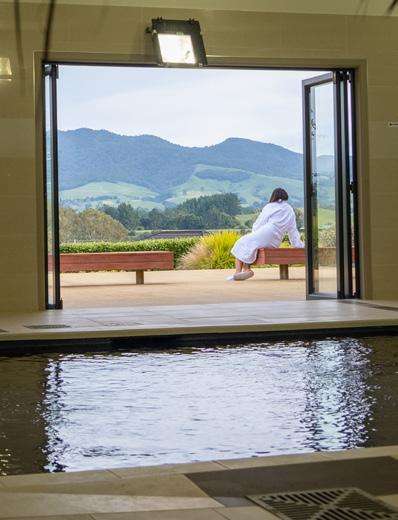
Subscribe for $29 (4 issues) Stay Informed for Under $25 a Year Get a two-year subscription for $49 or a one-year subscription for $29 Never miss an issue! Informed Investor magazine is a New Zealand luxury investment and lifestyle magazine which explains in plain English your financial options and how to build wealth. It covers the share market, property investment, KiwiSaver, personal finance, the economy, books, travel, and all the good things in life you can buy when you invest wisely. www.informedinvestor.co.nz/subscribe Terms & Conditions: 1. All prices for magazine subscriptions include free New Zealand delivery. 2. Please allow up to 10-13 weeks for your first delivery. 3. Your subscription will begin with the next available issue, and in most cases your magazine will be in your hands before it goes on sale in the shops. 4. Informed Investor magazine is published by Opes Media Limited, which handles delivery and stipulates the lead time shown above. 5. Offer available to New Zealand postal addresses only. Subscribe & Win Subscribe to Informed Investor this month and win a three day Fresh Start Retreat with Resolution Retreats, valued at $1740. Unwind in the peaceful settings of Lake Karapiro. Prize includes luxurious private chalet accommodation for one, all nutritionist meals and a complimentary Flowpresso lymphatic drainage treatment. Activities range from gentle, daily yoga and group fitness sessions to cooking classes, nutrition workshops and leading health and education workshops. Access to the wellness centre's five-star facilities including the luxury spa, saunas, steam rooms, indoor salt swimming pool, yoga chalet, tennis courts, private bush walks and jacuzzi. To be in the draw, head to www.informedinvestor.co.nz/subscribe and sign up for a two-year subscription before September 30, 2023. Your subscription will commence with the Summer issue of the magazine, out on November 27, 2023. Valued at $1740





















Visit us at Stand 617 at the Home Show 7-10 September 2023 Auckland Showgrounds, Greenlane Visit ashcrofthomes.co.nz or call us on 0800 377 588 Being Build Ready is about doing the groundwork now, so you can move forward with your new build when the time is right. As end-to-end experts, we will guide you through every step of the process, and by starting now, you’ll save time down the track by being in a position to start building faster. GET READY FOR TOMORROW’S MARKET TODAY











































































































































 Carlyon
Carlyon




























































 8.
1.
7.
8.
1.
7.








 1. twenty-seven names Just Desserts blazer – $750, 2. Ahem Point Mirabeau glasses – $890, 3. twenty-seven names True Blue shirt,
1. twenty-seven names Just Desserts blazer – $750, 2. Ahem Point Mirabeau glasses – $890, 3. twenty-seven names True Blue shirt,








 AUCKLAND BEIJING HANGZHOU HONG KONG NINGBO SHANGHAI CORDISHOTELS.COM
AUCKLAND BEIJING HANGZHOU HONG KONG NINGBO SHANGHAI CORDISHOTELS.COM






